

Gas Demand By Application In 2015
Technology Effects On U.S. L-48 Gas Supply
Transition Of Electric Power Industry To Decentralized Power Generation
Share Of Total Gas Demand Used In Electricity Generation
Distributed Generation Capacity
Large Non-Central Generation Capacity
Utility And Merchant Generation Capacity
Growth In Merchant Generation Capacity
Growth In Generation By Category
Estimated Average Size And Number Of Generators
Implications Of Transition In Electric Power Industry
Growing Reliance On Gulf Of Mexico And Canada
Gulf Of Mexico Total Drilling Activity
Balance Offshore Production And Reserve Additions
Offshore Shelf Gas Production By Water Depth
Implications Of Reliance On Gulf And Canada For U.S. Gas Supply
Move To Just-In-Time Gas Production Methods
Gas Deliverability And Demand Tolerance
Correlation: Deepwater Cycle Time And R/P Ratio
Reserve Additions Per Drilling Rig
Technology Effects On L-48 Gas Production
Implications Of Move To Just-In-Time Gas Production Methods



The baseline projection is not derived from the views of GRI members. It represents GRI management’s view of the most likely future based on current regulations, legislation, and national energy policy. While GRI monitors state and federal energy policy initiatives, until these initiatives are actually incorporated into legislation and the resultant impacts determined, GRI does not consider them in the baseline projection.
To interpret the results of the GRI baseline projection, it is important to understand the underlying assumption about gas technology improvement. The baseline projection includes the expected impact of GRI RD&C on end-use technology advances where those advances are consistent with established historical trends.
The projection does not include the effects of technology advances resulting from the GRI RD&C program that could be called technology breakthroughs or those that permit gas to compete in markets where it has historically had no presence. This qualification is particularly relevant to end-use technologies sponsored by GRI which are, in a number of cases, applicable to markets where gas has previously had little presence (i.e., vehicles, cooling, etc.). The impact of these technologies would be incremental to the historical trend. However, the impacts of new GRI end-use technologies, which have been commercially introduced into the market, are included in the analysis.
The gas supply technology premises are based on observable industry activity and more recent trends which, GRI believes, are representative of the future impact of gas supply technologies on industry activity. The projection should be interpreted as including the complete impact of GRI-sponsored gas supply technology work since supply research has a direct path to adoption through producer involvement in the GRI RD&C program.
This paper summarizes the 2000 Edition of the GRI Baseline Projection of U.S. Energy Supply and Demand. It focuses on three key trends that will shape energy consumption and supply patterns over the next few decades. The first is the steady transformation of the electric generation industry from one dominated by regulated utilities to one relying on decentralized unregulated power generators. The second is the growing importance of gas supply from the Gulf of Mexico and Canada. Expectations of a 30 Tcf demand future are only possible with a sharp growth in gas supply from the Gulf and Canada. Last, the fundamental operation of the gas exploration and production industry is changing. Producers are rapidly adopting the principals of just-in-time manufacturing as a way to cut risk and monetize their gas resources. This change in approach has important implications for supply reliability and price.
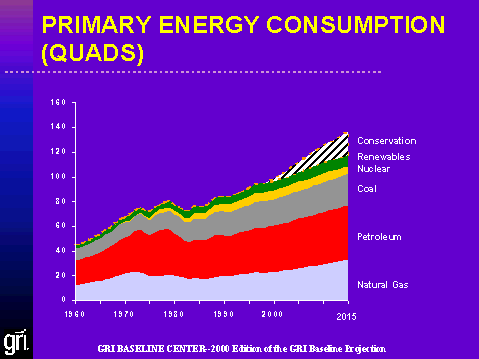
Total primary energy consumption is projected to increase from 94.4 quads in 1998 to 117.7 quads by the year 2015 or at an annual average rate of 1.3 percent per year. This is equal to 60 percent of the rate of growth in GDP (2.2 percent per year) over the same period. This figure summarizes total primary energy consumption and shows the shares contributed by each fuel. It also illustrates the projected role which energy conservation, as measured by the decline in primary energy intensity, plays in meeting energy requirements. This is energy that would have been produced, delivered, and consumed if not for improvements in energy conservation. Between 1998 and 2015, energy consumption per dollar of GDP is projected to fall from 12,580 Btu to 10,880 Btu per 1992$ or at 0.9 percent per year. This decline in energy intensity offsets over 18 quads of energy consumption by 2015 that would have occurred if not for conservation.
Primary gas demand is projected to grow from 21.8 quads (21.2 Tcf) in 1998 to 33.5 quads (32.7 Tcf) by 2015. Total delivered gas demand (including gas synthetics and coal gas) grows from 21.9 quads (21.3 Tcf) in 1998 to 33.7 quads (32.8 Tcf) by 2015. Primary gas consumption is projected to grow at an annual rate of 2.6 percent, about 60 percent faster than the rate of growth in total primary energy consumption. As a result, gas is projected to capture a growing share of total primary energy consumption, increasing from 23 percent in 1998 to over 28 percent by 2015. While total gas demand easily surpasses the historic high of 22.7 quads reached in 1972, its share of total primary energy consumption is still well below the historic peak of 32 percent. The projected growth in primary gas demand emphasizes the need to ensure that adequate gas supplies are available and deliverable at competitive prices.
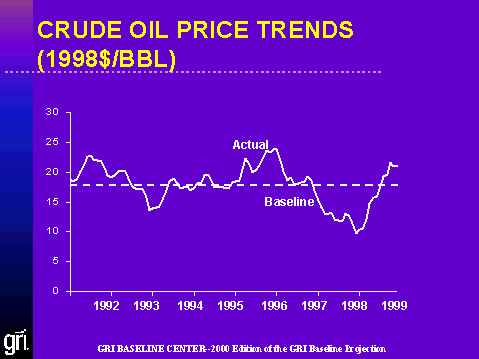
A key determining factor in any energy projection is price. While crude oil prices (defined here as the U.S. Composite Refiners Acquisition Cost of Crude Oil or RAC) are a poor gauge of the trend in energy prices because of their shrinking use in many sectors and the growing limits on fuel switching, they are still an important energy price indicator followed by the general public and many energy analysts. Crude oil prices have been very volatile over the last few years. This makes it difficult to determine the long-term trend. The following presents the approach taken by GRI toward crude oil prices in the baseline projection.
GRI uses a commodity approach as the basis of the expectation for crude oil prices. Under this approach, there are limited prospects for a real dollar increase in the long-term price trend of a commodity such as crude oil. One of the goals of adopting this approach was to better reflect the long-term historical path of prices (essentially flat in real terms). A secondary goal was to avoid the constant year-after-year parallel drops and increases in the price path simply tracking the change in the base year price.
This philosophy does not imply that prices will not fluctuate from month-to-month or year-to-year. This type of fluctuation should be expected. One-time political events, some of which may be significant and enduring, or price pressures or weaknesses during a strong or weak period of economic growth may affect short-term prices. However, because of the complex interplay of economic, political, and social decisions on a worldwide scale it is difficult, if not impossible, to anticipate these short-term events.
Prices are currently being impacted by just such an event, the concerted effort by OPEC to constrain production. Because of OPEC’s actions, world crude oil prices are currently well above a market-based equilibrium level. However, under a commodity approach, it is believed that this effort will prove unsustainable and the quotas will be exceeded in the short term (short term is defined here as being as long as a few years or as short as a few months). Once the quotas are exceeded, prices will move toward the market-based equilibrium price.
Prior to the OPEC production constraints, the opposite side of the commodity cycle was experienced. The currency crisis in Asia led to a decline in oil demand and a sharp drop in prices during 1998. Between 1993 and 1997, Asian oil demand had increased in each year by an average of almost 900 thousand barrels per day. In 1998, demand declined by almost 500 thousand barrels per day, a swing of 1.4 million barrels per day. As a result of the shortfall in demand, the price of crude oil fell to a low of $9.84 per barrel (RAC) in December 1998.
Neither the sharp drop in prices in 1998 nor the firming of price in 1999 represents a new long-term equilibrium trend in crude oil prices. They illustrate the impact of one time events on prices in the short term. The price cycles over the last two years are completely consistent with taking a commodity approach toward the outlook for crude oil prices. However, the events that precipitated these cycles were unpredictable. None of the events impacting markets in these two periods can be identified as long-term fundamental factors. As a result, GRI has chosen to rely on the historical long-term trend of real crude oil prices as the basis for prices in long term.
After correcting from current high levels, crude oil prices are assumed to resume an equilibrium trend of roughly $18 per barrel (1998$). Again, this does not imply that prices will not fluctuate around this trend, they will, it only implies that prices will move along this trend within a band. A real dollar price of $18 per barrel implies that the nominal price will gradually rise to $30 per barrel by 2015.
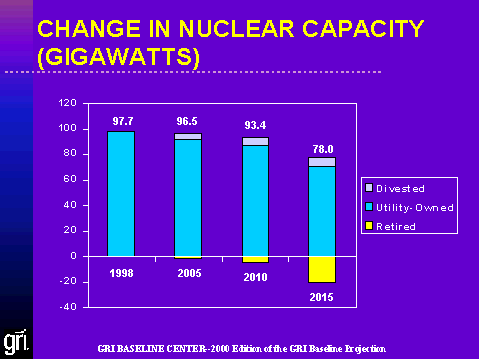
Nuclear energy is an important contributor to U.S. energy supply. In 1998, nuclear energy met over 18 percent of total U.S. electricity generation (including that generated by utilities, independent power producers, and industrial and commercial power generators). Nuclear is also a key determinant of future gas consumption. If all of the nuclear capacity were retired, 6.1 quads of other energy sources (at an average heat rate of 9,000 Btu per kWh) would be consumed to replace the generation. Much of this incremental load would fall to natural gas. Therefore, the continued operation or retirement of nuclear generating capacity is a key determinant of future gas consumption levels.
In recent years, the GRI Baseline Projection had relied on three basic premises for dealing with nuclear capacity additions, life extension, and retirements. The first is that electric industry restructuring would lead to the accelerated retirement of some nuclear facilities prior to the end of their licensed life. This was based on an assumption that some nuclear plants would be uncompetitive in a more deregulated market because of high capital costs, an inability to follow load, and reliability issues. In addition to assuming some early retirements, the analysis incorporated and accepted all announced retirements. Last, the projection included an assumption that no new nuclear plants would be built and that there would be no life extension.
GRI felt that this approach needed to be reconsidered in light of a number of recent events and trends, including the following:
Given these events and trends, a new approach toward handling nuclear
capacity was adopted. The revised approach was based on the following principals:
1. While all announced retirements are incorporated, only a very limited
number of additional early retirements are assumed.
2. Some of the plants that would have been retired under the old approach
are now assumed to be divested by utilities. The new operators are assumed
to continue to operate the facilities, making the necessary investments
to make them competitive. In this case, the assumptions in the projection
are relatively conservative. Actual events since the projection was completed
have exceeded expectations. For example, the Oyster Creek facility has
been divested, but that event was the assumed in the projection.
3. The projection continues to assume that no new nuclear plants will
be constructed. It is felt that the construction of new plants is still
a tough sell with the general public.
4. Last, it was assumed that all plants that have filed for life extension
will receive approval and that a relatively aggressive, but limited, number
of additional plants will be granted life extension. This is a conservative
assumption. It is likely that once the initial filers are granted life
extension, a substantial number of other plant operators will file using
the first filings as a template.
The baseline projection includes 97.7 gigawatts of total nuclear generating capacity (net summer dependable) in 1998, all of which is utility owned. Central utilities are projected to divest 4.5 gigawatts of capacity to independent power generators (IPGs) over the course of the projection. Of the remaining utility-owned capacity (93.2 gigawatts), 19.7 gigawatts is assumed to be retired by 2015. Most of this capacity is retired based on the plants licensed life. The capacity retired would have been greater, an additional 14 gigawatts, if we had not assumed the life extension of some existing facilities. As these plants are retired, other energy sources must replace their contribution. Virtually all of the existing nuclear capacity in the U.S. is currently scheduled for retirement by 2030.
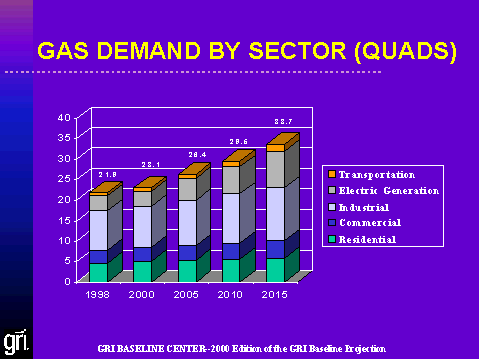
This figure summarizes the projection of gas demand by end-use sector. Gas demand is projected to grow in all markets. However, the dominant portion of the projected growth is in the price-sensitive electric generation and industrial markets.
Gas demand in the electric generation sector (including only central utilities and independent power generators) is projected to grow from 3.7 quads in 1998 to 8.9 quads by 2015. Independent power generators account for all of the growth in gas demand. Utility consumption of gas declines over the projection as capacity is divested to non-regulated subsidiaries or other entities. Industrial gas demand is projected to grow from 9.8 quads in 1998 to 13.0 quads by 2015. Growth in gas demand in the electric generation and industrial sectors accounts for over 70 percent of the projected growth in total gas demand between 1998 and 2015.
While these price-sensitive applications hold the greatest potential for growth, gas demand also increases in the residential and commercial markets for space conditioning, water heating, and cooking, as well as for other end-use applications. Residential gas demand is projected to grow from 4.6 quads in 1998 to 5.8 quads 2015. Commercial gas demand is projected to increase from 3.1 quads in 1998 to 4.3 quads by 2015. However, while residential and commercial gas demand is projected to grow, they account for a declining share of total gas demand.
The projection also includes growth in gas demand for transportation (including gas used by pipelines for transmission and by vehicles). Pipeline consumption of gas grows roughly consistent with the growth in total gas demand. Total transportation sector gas demand is projected to grow from 0.7 quad in 1998 to 1.7 quads by 2015. While pipeline consumption of gas for transmission grows, most of the growth in transportation gas demand is projected to be accounted for by vehicles. Vehicle demand for gas grows from virtually nothing in 1998 to almost 0.6 quad by 2015. Most of this growth is projected to occur after the year 2005. The near-term target is medium- and heavy-duty trucks and buses. In the long-term, the target shifts to light-duty and other medium-duty vehicles.
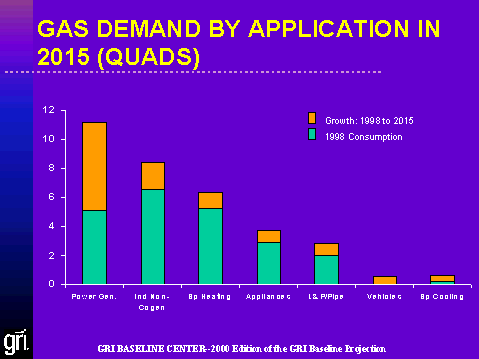
This figure summarizes the projection of gas demand by energy application as opposed to end-use sector. This format moves the discussion of demand closer to the actual technologies using gas. The applications are listed, from left to right, in order of the magnitude of projected growth. The base portion of each bar shows gas consumption in 1998 by application.
The greatest potential for gas growth is in electric power generation. Power generation alone accounts for just over 50 percent of the total growth in gas demand between 1998 and 2015. Power generation as defined here includes not only central-station generators (utilities and independent power producers), but also commercial and industrial cogenerators, and distributed generation. Gas consumption for electric power generation is projected to grow by 6.0 quads between 1998 and 2015, from 5 to 11 quads.
The second greatest potential for growth is in industrial non-electric power generation applications (i.e., process heat, process steam, and gas use as a feedstock). Industrial non-electric power generation fuel use is projected to grow by 1.9 quads between 1998 and 2015. The greatest portion of this growth is accounted for by increased demand for gas in process heat applications (e.g., fluid heating, metal melting, smelting, metal heating, metal heat-treating, drying, certain types of glass manufacturing, calcining, clay firing, etc.). In many cases, the fuel choice in these applications is limited because of product quality issues or other reasons related to manufacturing.
Gas demand for space heating is also shown to grow strongly between 1998 and 2015, by 1.1 quads. However, much of this growth stems from using 1998 as a starting point. Space heating load in 1998 was moderated by a warmer than normal winter. This reduced gas space heating consumption by about 0.5 quad versus comparable levels in 1997, a more “normal” winter.
While projected gas growth in the power generation and industrial non-electric power generation applications increases by the largest absolute amount, vehicle and space cooling demand grow by the largest percentage since gas plays only a very small role in both of these applications today. Gas demand by vehicles is projected to grow by about 550 tBtu between 1998 and 2015 (versus demand of 12 tBtu in 1998) and gas use in space cooling applications is projected to increase by over 3 times, from 180 tBtu in 1998 to almost 660 tBtu by 2015.
The outlook presented here includes numerous opportunities for gas demand growth. Many of these opportunities are dependent on new gas technologies. The baseline projection seeks to highlight the potential offered by continued gas technology improvement in end-use applications, exploration and development, and operations. While the projection assumes continued progress in gas technologies consistent with the long-term historical trend, the actual attainment of the gas market opportunities presented here depends on the degree to which the technology progress is actually fulfilled.
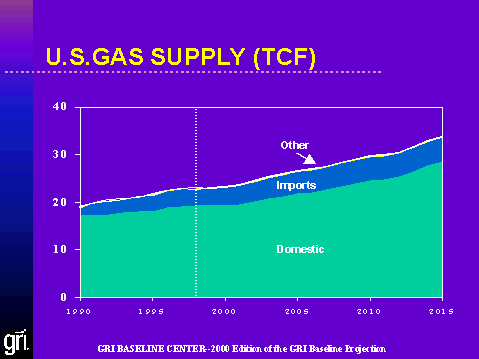
This figure summarizes the U.S. gas supply slate in the 2000 Edition of the GRI Baseline Projection. Gas supply sources are categorized as U.S. domestic production (lower-48 and Alaska), imports (Canada, Mexico, and LNG), and other (coal gas and other supplements).
U.S. domestic gas production grew to close to record levels during the 1990s despite real (1998$) gas prices which averaged only about one-half the levels in the 1980s. While year-to-year fluctuations in gas production can be expected due to shifting prices, demand, and E&P investments, expectations generally hold that U.S. gas production will continue to set records in the future. Furthermore, there are other potential sources of gas supply not considered in the baseline projection or only partially considered (e.g., hydrates, deep gas onshore, enhanced recovery from existing fields, liquefied natural gas) that could allow growth in gas supply to levels above those shown in the analysis.
Increased domestic lower-48 gas production dominates growth in U.S. gas supply. Total lower-48 gas production grows from 19 Tcf in 1998 to almost 28 Tcf by 2015. Just after 2005, lower-48 gas production exceeds its 1973 peak of 21.5 Tcf. Much of the growth in lower-48 gas production prior to 2010 reflects increased supply from the Gulf of Mexico and Norphlet. By 2015, gas production from offshore Gulf of Mexico reaches over 8 Tcf. By way of comparison, offshore Gulf of Mexico production was about 5 Tcf in 1998. Norphlet production is projected to increase from about 400 Bcf in 1998 to 1.1 Tcf by 2015. Production from high-permeability onshore reservoirs below 10,000 feet is also a major contributor to increased gas production. After 2010, the growth in lower-48 gas production is dominated by increased production from less conventional gas sources, principally low-permeability (“tight”) reservoirs. The increased role of deeper onshore and offshore reservoirs, as well as less conventional gas resources, depends on the sustained development and application of new technologies.
Imports (predominantly pipeline imports from Canada, but also including LNG) play a key role in meeting U.S. gas supply requirements. Imports account for just under 16 percent of total U.S. gas supply in 1998. Through 2005, imports are expected to increase rapidly, growing from 3.6 Tcf in 1998 (including gas in transit) to 4.6 Tcf by 2005. By 2005, imports account for 17 percent of total U.S. gas supply. While the growth in imports slows after 2005, imports continue to grow reaching 4.9 Tcf by 2010 before leveling off.
The potential exists for continued growth in imports, particularly Canadian pipeline imports, to levels above those in the baseline projection. For example, the 2000 edition of the baseline projection does not consider the potential for Canadian production from the Mackenzie Delta. Further, the projection includes relatively limited expectations for the Canadian Maritime resource that can still be considered virgin territory and may offer much more potential than currently expected. The rapid growth in worldwide LNG trade has barely touched the United States. The “topping out” of imports in the 2000 edition of the projection reflects the assumptions in the model, not a resource constraint.
Growth in pipeline capacity is not a constraint on growth in gas supply. The baseline projection considers the rapid growth in gas pipeline capacity that is now taking place in the U.S. and Canada, including specific regional impacts. The analysis includes an evaluation of the proposed projects for inclusion in the projection and selects a subset of the projects that are believed likely to be completed. By 2015, the 2000 edition of the projection incorporates cumulative interregional pipeline capacity additions valued at $43.4 billion (1998$). Pipeline capacity does not appear to be a constraining issue. If supply is available, history has demonstrated that the pipelines will be built as needed. It is simply an investment and engineering issue.
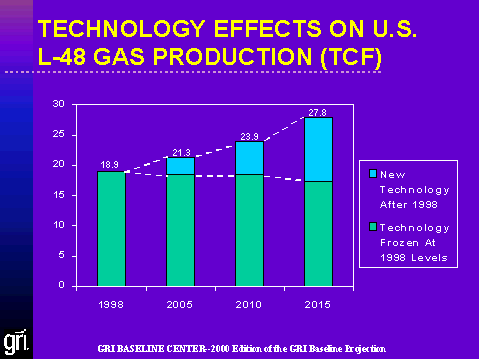
This figure presents the trend in lower-48 domestic gas supply from the 2000 projection allocated to the supply expected to occur if technology does not advance beyond 1998 levels and the supply that is expected to occur if technology continues to advance for roughly the next 20 years according to the expectations in the projection.
Continuing technology advances account for a growing share of lower-48 domestic gas supply. By the year 2015, about 30 percent of gas supply depends on the availability of new technology. Under a static technology picture, U.S. lower-48 gas production continues to grow through the year 2005 before it begins to decline. With a static technology scenario, U.S. lower-48 gas production would fall to levels less than it was in 1998 by 2015. Under this scenario, the projected growth in gas consumption shown in the 2000 edition of the baseline projection could simply not occur.
The 2000 Edition of the GRI Baseline Projection shows lower-48 gas supply growing from 18.9 Tcf in 1998 to 27.8 Tcf by 2015. This growth can only be accomplished with continued investment consistent with historical experience, an increase in drilling activity (by significant, but not heroic amounts), and continued gas supply technology improvement at levels similar to historical experience. Providing a higher level of gas supply will require that one or more of these factors increase beyond current expectations. This highlights the value of technology improvements that increase the return per unit of effort. To the extent success rates can be improved, costs reduced, or risks lowered beyond the assumptions embedded in the 2000 baseline projection, gas supply can grow to levels above those shown in the projection.
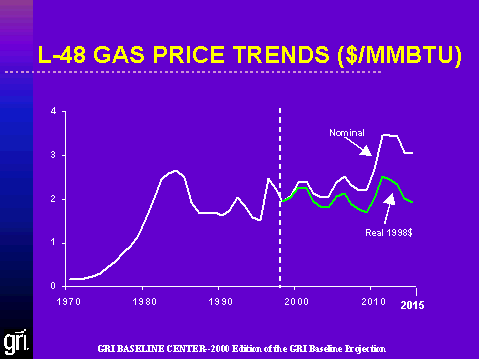
The 2000 baseline projection describes a world in which real oil prices remain flat while real coal and electricity prices decline. Gas prices will need to be competitive in this environment if gas demand is to grow. This figure illustrates historical and projected lower-48 gas price cycles attributable to the boom and bust cycles in the E&P industry. The prices shown represent delivered to pipeline prices that include gathering charges. Real (1998$) gas prices average about $2.00 per MMBtu with price variation of as much as 25 percent due to cycles in the industry. Gas prices are anticipated to remain relatively high in 2000 as low drilling levels, resulting from the oil price collapse in 1998, impact the market. As a result of the tight supply condition in the near-term, gas prices could spike significantly in response to extreme weather conditions. However, the higher oil and gas prices in 1999 and 2000 will have the positive result of accelerating drilling activity.
Post-2002 or so, real lower-48 prices are expected to soften as growing production from the Gulf of Mexico and rising Canadian imports (both from Alberta and the Maritime Provinces) begin to pressure domestic supply. The general trend in real prices will be down over this period. That doesn’t rule out intermittent price cycles but the overall trend will be down. Real lower-48 gas prices are projected to oscillate with “peaks” occurring in 2007 and 2011 and “valleys” in 2004 and 2009. At the extreme, prices (real 1998$) range from $1.71 per MMBtu at the low in 2009 to a peak of $2.52 per MMBtu in 2011. In nominal dollars (the actual price paid for gas in the year purchased), lower-48 gas prices are projected to increase from $1.95 per MMBtu in 1998 to $3.05 per MMBtu by 2015. Nominal prices are projected to spike to as high as $3.47 and fall as low as $1.95 per MMBtu over the projection.
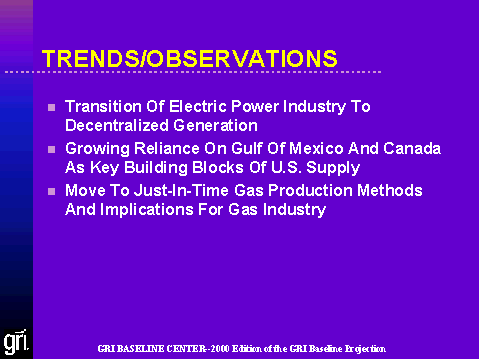
There are a number of important observations that can be drawn from the 2000 Edition of the GRI Baseline Projection. First, the growth in gas demand is dependent on significant growth in demand for electricity generation. This projection is not unique among contemporary projections. However, the growth in demand for electricity generation is taking place as the electric industry undergoes a transition driven by regulatory change, growing emissions constraints, and technology change. The industry is transforming from one dominated by regulated utilities to one relying on decentralized unregulated power generators. This creates risk to the gas industry in depending on one sector for so much of its future growth. The following examines the transition in the electric industry as captured in the 2000 edition of the projection and the implications for the gas industry.
Second, the required increase in U.S. gas supply needed to meet demand growth depends on two key building blocks: increased gas supply from the Gulf of Mexico, particularly the deeper waters of the Gulf, and Canadian imports. Expectations for a 30 Tcf demand future are only possible with strong growth in gas supply from the Gulf and Canada. Success in achieving this growth will ultimately determine the role which gas plays in future energy markets in the United States. This discussion will examine the expectations for growth, the challenges, and the implications.
Last, the fundamental operation of the gas exploration and production industry is changing. Producers are rapidly adopting the principals of just-in-time manufacturing as a way to cut risk and monetize their gas resources. A key implication of this change is that proven reserves behind production will be less in the future than historical experience. This has important implications for supply reliability and price volatility. This change in operational practice is incorporated in the 2000 edition of the projection. The implication of this change in practice will be discussed in the following.

For much of this century, public utility decisions were predicated on a “regulatory compact” between the utilities, regulators, and the public. Under this agreement, utilities were obligated to build generation and distribution facilities to serve customers in return for the provision of an exclusive franchise or monopoly and an allowed rate of return on capital investment. Through the 1980s the economies of scale of electric generation technologies justified this regulatory approach. Electric loads were aggregated in a region and utilities built larger and larger generating units with progressively lower costs to serve those loads.
The justification for this approach began to unravel in the late 1970s. Advances in generation technology and low gas prices started to reverse the traditional relationship between size and cost in generating systems. Smaller gas-fired combined-cycle generating units were being introduced that could generate electricity at costs below the embedded cost of many electric utilities. Further, the enactment of the Public Utility Regulatory Policies Act (PURPA) in 1978 and the Energy Policy Act in 1992 encouraged competition and acted to open up markets. Additional actions by the Federal Energy Regulatory Commission (FERC Orders 888 and 889 in 1996) and by the states in more recent years have further opened markets. To date, 24 states have either deregulated or begun to deregulate their electric industries.
Today, with growing competition and continued technology improvements, decentralized generation is on the threshold of making major advances in market share. The following reviews the continuing change in the fundamental structure of the electric industry, as projected in the 2000 Edition of the GRI Baseline Projection, and the implications for the gas industry.
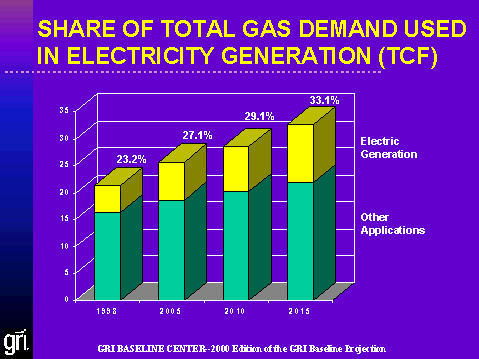
Why is understanding the transition in the electric industry important to the natural gas industry? As noted earlier, growth in gas demand for electricity generation is projected to account for a disproportionate share of the total increase in gas demand over the next twenty years, accounting for just over 50 percent of the total growth in gas demand between 1998 and 2015. Commensurate with this increase, the share of total gas consumption accounted for by gas consumed in electric power generation also increases from 23 percent in 1998 to 33 percent by 2015.
This emphasizes the importance of understanding the transition in the electric industry and their implication for the gas industry. Addressing the changes taking place in the structure and operation of the electric industry will require planning and investment by the gas industry if gas is to capture the share of the market described in the 2000 baseline projection.
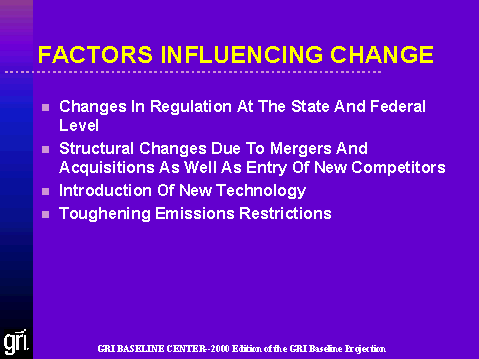
There are four key factors influencing change in the electric industry as listed here.
Changes In Regulation: The electric industry is not being deregulated, as many pundits claim, the industry is moving to a more competitive form of regulation. There will still be regulations, but the rules have been changed to open up markets to competition, to limit market power, and to protect the consumer in this environment. Unfortunately, these regulatory changes are being implemented in a haphazard format with each state addressing the issues separately. A key feature of the regulatory change is the functional or operational separation of generation from the merchant function. Electricity has become a commodity and generation has been widely opened to competition. This has not been a perfect process and there are still rules that will need to be changed to more completely and efficiently open the market. For example, distributed generation is still encumbered in many markets by outdated rules that make it almost impossible to install capacity.
Structural Changes: Due to mergers and acquisitions we are seeing two changes. First, electric utilities that predominantly existed at the state level are now expanding to the regional level. It is likely that in a few years there will only be a few large regional utilities. Second, the electric and gas industries are rapidly converging, particularly the merchant and transmission functions. The combined industries will be better able to manage risk and has the potential of offering a broader list of products to consumers. However, from the perspective of decentralizing generation, the most important structural change has been the entry of new competitors at all levels. Merchant generators (both new companies and unregulated subsidiaries of existing companies) have aggressively pursued opportunities in markets where high electricity prices offer the potential of financial reward. Further, companies from other industries have also begun to enter the market. For example, in Canada, which is also deregulating, Sears has recently entered the merchant function in conjunction with TransCanada Pipeline.
New Technologies: Much of the initial impetus for restructuring was provided by the introduction of new technologies that offered potential financial advantage to specific customers or customer classes. For example, cogeneration facilities, which were adopted in the industrial sector, provided a way for the customers to improve service reliability and reduce electricity costs. The introduction of gas-fired combined-cycle turbine technology offered performance that far exceeded what was offered by the average utility and has become a favorite of both cogenerators and independent power generators. With continued improvement combined-cycle heat rates are now approaching 6,000 Btu per kWh (versus a utility average of 10,465 Btu per kWh in 1998). The introduction of microturbines and fuel cells has the potential to further impact the economics of electricity generation. These units are typically sized from 25 to 300 kilowatts and offer enhanced reliability, avoidance of transmission charges, and low emissions.
Emissions Restrictions: In 1998, electric generation accounted for about 65 percent of all sulfur dioxide, 25 percent of nitrogen oxide, and 15 percent of point source emissions of particulate matter. It also accounted for roughly one-third of anthropogenic carbon dioxide emissions. Given the size of electric generations contribution to air emissions, emissions regulations are likely to continue to play a significant role in this sector. An example is the increasing pressure by EPA to move to a fuel neutral emissions standard. This would greatly penalize traditional large-scale coal generators if applied to existing facilities and will further enforce the shift to gas in new facilities. This will further push the electric industry toward decentralization of generation since the typical gas facility tends to be much smaller in size than the capacity historically installed by utilities.
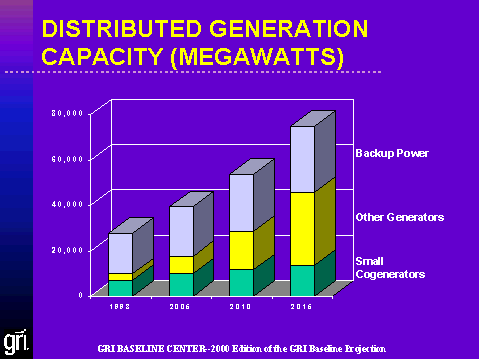
The next few figures summarize the results of the 2000 edition of the baseline projection for electricity generation. It highlights how the mix of generating capacity by category will change as the electric industry goes through its transition to a more decentralized generation configuration. The figure covers distributed generating capacity owned by electric utilities, merchant power generators, and generators in the industrial and commercial sectors.
There are two basic types of distributed generation: customer-based and grid-based distributed generation (or dispersed generation). Customer-based distributed generation generally consists of small units (25 Megawatts or less) that are typically used for on-site generation in the residential, commercial, institutional, or industrial markets. The power generated is primarily used for peak shaving, backup power, ancillary services (voltage support, reliability, etc.) and energy efficient heat recovery (cogeneration). Grid-based distributed generation consists of somewhat larger units, up to 100 MW, and is typically owned by utilities. This type of capacity is primarily used to provide voltage support, peak shaving, and to avoid transmission investments.
There is a substantial base of distributed generation in place today, roughly 28,000 megawatts. Most of these units are backup generators primarily using diesel fuel. These units typically have very low capacity factors, 2 or 3 percent, and, on aggregate, consume very little energy. There is also a substantial amount of small size cogeneration capacity in place today that is primarily fueled by natural gas and petroleum.
Distributed generation capacity is projected to grow very rapidly over the next 15 to 20 years. Total distributed generation capacity is projected to grow from 28,000 megawatts in 1998 to about 75,000 megawatts by 2015 or at 6.0 percent per year. The vast majority of this growth will be in other generators (predominately microturbines and fuel cells). Other generator capacity is projected to grow from 3,200 megawatts in 1998 to 32,000 megawatts by 2015.
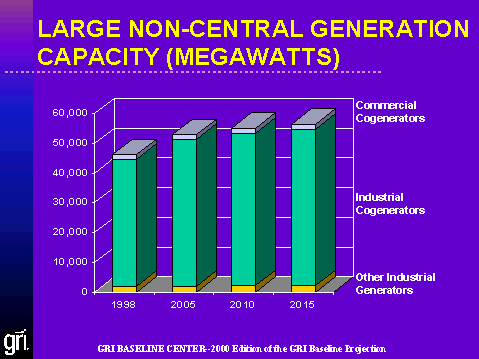
Large non-central generation capacity is what is typically refer to as cogeneration capacity. This includes units that are larger than 25 megawatts and they can be either qualifying or non-qualifying. These larger units typically produce both useful heat and electricity. However, the amount of heat produced can vary widely. Industrial cogenerators dominate this category, many built during the 1980s under PURPA. A high percentage of the total capacity in these cogeneration systems is typically installed at large industrial complexes (e.g., refiners, chemical plants, etc.).
The 2000 edition of the baseline projection shows little growth in large non-central generation capacity over the projection. Much of the growth during the 1980s and early 1990s in cogeneration capacity was in response to high buyback rates set by states which created an incentive for the construction of so-called PURPA machines. This was non-traditional cogeneration capacity built specifically to sell electricity. These units typically had very high electric power-to-heat ratios. However, with the elimination of these high buyback rates as part of electric industry restructuring, these non-traditional cogeneration projects are not expected to be developed after 2005. These projects are expected to be redesigned as merchant power projects. A limited number of traditional cogeneration projects will be built to serve steam demand where they are economic, but little excess electricity will be generated from these projects for resale.
Large non-central generation capacity is projected to grow from 46,000 megawatts in 1998 to 56,500 megawatts by 2015. Almost all of this growth will occur between 1998 and 2005 as a number of non-traditional cogeneration units are completed.

The vast majority of generating capacity in 1998, 735 gigawatts (735,000 megawatts), is owned by central utilities. Central utility capacity varies greatly in size, ranging from very large 1,000 megawatt and greater nuclear and coal-fired units, predominantly used for base load generation, to small 100 megawatt steam and combustion turbines units, used for peaking applications. The size of utility-owned coal-fired generating units average just over 300 megawatts, gas and oil-fired units average 200 megawatts, and nuclear units a little over 1,000 megawatts. However, over the past few years, very few of the larger units have been built. To date in 1999, the average size of a newly installed unit is only 29 megawatts. This small size owes to a number of factors: little installation of base load generating capacity, the uncertainty resulting from restructuring, and heavy demand for peaking units. Much of the new capacity that is being installed is gas-fired, either combustion turbines or combined cycle units.
As part of restructuring, many central utilities are getting out of the commodity generation business either by choice or as part of state restructuring legislation. Much of this capacity is being sold to merchant plant operators. As of August 1999, over 23,000 megawatts of central utility capacity have been sold to merchant generators and, cumulatively since 1998, over 40,000 megawatts have been sold. These sale are expected to continue as electric industry restructuring progresses. As a result, merchant generation capacity is projected to grow sharply over the next few years and central utility generating capacity is projected to decline. Further, virtually all of the new capacity built in the coming years is likely to be built by unregulated merchant generators.
Central utility generating capacity is projected to decline from 735 gigawatts in 1998 to 530 gigawatts by 2015. At the same time, merchant generating capacity is projected to grow from 40 gigawatts in 1998 to over 430 gigawatts by 2015. All of the incremental generation of electricity will be provided by merchant capacity in the coming years. Much of this merchant capacity, particularly over the next 10 years, will be gas fired as merchant generators attempt to limit risk and avoid emissions issues.
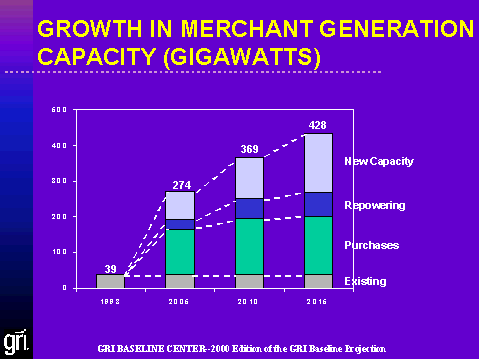
While much of the growth in merchant generating capacity in the near term is from the purchase of divested central utility capacity, these purchases decline in significance post 2005. Merchant generators are projected to cumulatively purchase in excess of 170 gigawatts of central utility capacity by 2015. About one-half of this purchased capacity will be gas or oil-fired and the other half coal-fired. However, merchant purchases also include some nuclear and hydro capacity.
While purchases of divested capacity help to establish the role of merchant generators in the industry, they are also projected to build a substantial amount of new generating capacity and to repower purchased capacity. Currently, there are over 125 gigawatts of new merchant capacity proposed for construction. Many of these plants will never be built (some are competing in markets which can not sustain the amount of capacity currently proposed, some are poorly financed, and others are simply uneconomic), but the large amount of capacity proposed clearly indicates the high level of interest by merchant generators in entering markets where an opportunity exists. The 2000 edition of the baseline projection estimates that merchant generators will build and begin operation of 80 gigawatts of new capacity by 2005 and, cumulatively, 165 gigawatts by 2015. Much of this new capacity will be gas-fired combined cycle or combustion turbine units. Gas-fired units are projected to account for over 70 percent of all of new capacity build by merchant generators. These units tend to be smaller then those historically built by central utilities, averaging between 100 and 200 megawatts per unit.
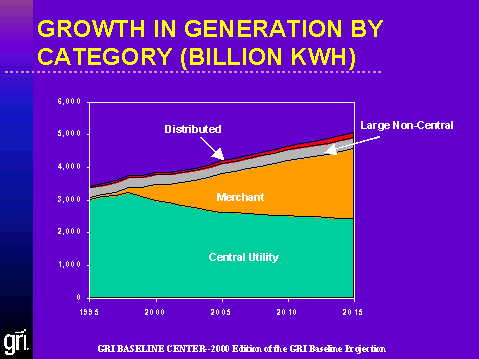
Total electricity generation from all sources is projected to grow from 3,700 billion kWh in 1998 to over 5,000 billion kWh by 2015, or at 1.8 percent per year. As a result of all of the changes taking place in the electric generation industry, the share of generation represented by central utilities will decline sharply over the next 15 to 20 years. All of the incremental generation and a growing share of total generation will be provided by non-utility generators. Merchant generators will provide the biggest share, but generation by large non-central generators and distributed generators will also grow. Total central utility generation of electricity is projected to fall from just over 3,200 billion kWh in 1998 to under 2,400 billion kWh by 2015. The utility share of total generation will fall from 85 percent in 1998 to under 50 percent by 2015.
There are more optimistic projections for distributed generation than that included in the 2000 edition of the baseline projection. It will be difficult for distributed generation to penetrate the market given the embedded infrastructure of other generators and existing permitting issues at the state and local level. However, distributed generation grows the most rapidly of any generating category, 6.5 percent per year from 1998 to 2015. It grows from accounting for only 1.5 percent of total generation in 1998 to over 3 percent by 2015. This suggests that distributed generation will clearly become a much more significant player in generation in the future than it is today. This role could be further enhanced with continued technology improvement and the removal of the roadblocks to penetration.

The growth in merchant capacity with its greater reliance on small gas-fired generating units and the increased role for distributed generators implies a declining average generating unit size over time and an increase in the total number of generating units as electricity demand increases. The average size of generating units is projected to fall from 92 megawatts in 1998 to less than 75 megawatts by 2015. At the same time, the projected number of generating units will increase from 9,200 generating units in 1998 to over 14,300 units by 2015.
This change has potentially a number of important implications:
1. The location of generating capacity will be more greatly dispersed
2. The number of individual customers purchasing energy for generation
will be much greater than it is today, and
3. With a greater number of customers controlling generation, the potential
exists for increased daily and monthly fluctuations in power availability
and fuel demand for generation.
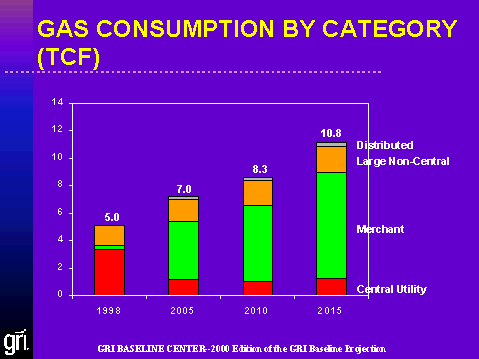
What does this all mean for gas consumption? New distributed and merchant generating capacity is anticipated to be predominantly gas fired. Large non-central generating capacity is also predominantly gas fired today and is expected to remain so in the future. Finally, while much of the existing gas-fired central utility owned generating capacity is anticipated to be divested, selected utilities will continue to use natural gas to meet peak generating requirements. While gas consumption in the divested capacity may fall somewhat over the next 5 to 10 years as the units are repowered or retired by merchant generators, that decline will be offset by growth from new gas-fired merchant capacity. However, the decline in gas consumption will vary significantly by region depending on the extent of gas use today, merchant activity, and regional fuel preference.
The 2000 edition of the baseline projection shows gas consumption for electricity generation growing very sharply between 1998 and 2015, from 5 Tcf in 1998 to almost 11 Tcf by 2015. Merchant generators will account for the majority of the growth between 1998 and 2015 as well as the largest share of consumption post 2005. Merchant consumption of natural gas is projected to grow from 0.3 Tcf in 1998 to over 7.6 Tcf by 2015. Growth in gas consumption by distributed generators will also be strong, growing from virtually nothing in 1998, 30 Bcf, to over 320 Bcf by 2015. The percentage growth in gas consumption by large-scale non-central generating capacity will be more modest than recent historical experience, but still significant, growing from 1.4 to 1.9 Tcf between 1998 and 2015. Much of this growth takes place between 1998 and 2005 as plants under construction are completed. The bottom line is a very optimistic outlook for gas consumption for electricity generation.
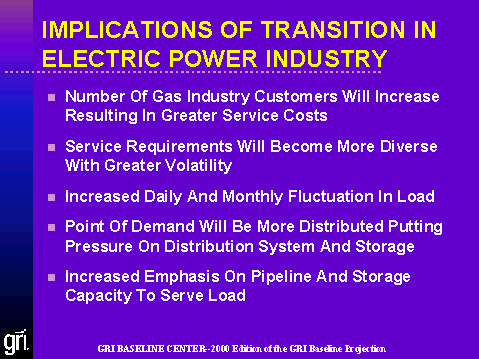
What are the implications for the gas industry of the transition taking place in the electric power industry, particularly the greater reliance on small-scale decentralized power generation? The move to smaller average sized units will imply a greater number of electric generation customers for the natural gas industry with smaller average volumes per customer. The generating units are also likely to be more widely dispersed on a geographic basis.
The smaller average size generating unit and the larger number of customers will increase the gas industry’s cost of serving electric generation customers. With a large number of generators, service offerings by the gas industry are likely to become broader to match the varying needs of the customers (e.g., mixtures of services such as commodity, transportation, storage, varying contract formats, etc.). Further, with a larger number of individual electric generating units, the potential exists for greater volatility in both daily and monthly gas loads as customers make independent decisions about the operation of the generating facilities.
The generating units are also likely to be situated closer to electricity loads, particularly with the growth in distributed generation capacity. Many of these units will need gas supply from local distribution systems. This is exactly the opposite of the trend in recent years where many generating units are taking service off transportation pipelines. The combination of greater geographic diversity in the siting of generating capacity and the increase in capacity located in urban and suburban areas will increase reliance on the distribution pipeline network and storage capacity, implying greater investment in both. The sheer size of the growth in gas demand for electricity generation will also imply a requirement for increased investment in long distance transmission capacity to ensure that the gas supplies can be delivered to the market.
All of these issues can be addressed by the gas industry. They are predominantly engineering and investment issues. However, steps need to be taken to plan for these changes.

Much was written in the trade press during 1999 about the decline in crude oil prices, the collapse in drilling activity, and the dire consequences for natural gas deliverability. Skeptics cited statistics illustrating the alarming decline rate in natural gas production, particularly from the Gulf of Mexico, with the implication that the drilling slump would worsen and that future gas supply shortages were eminent. Yet, by the end of 1999, no gas shortage had materialized, the market appears to be in balance, and prices have even begun to soften. The most dire consequences were avoided because new offshore deepwater production and increased Canadian imports silently stepped in to offset what declines did occur in mature supply regions.
The events of 1999 were a microcosm of how gas supply requirements will be met in the future as demand levels grow. A 30 Tcf future for gas demand is only achievable with contributions from all production regions and from all types of gas. The supply analysis in the 2000 Edition of the GRI Baseline Projection echoes this conclusion. However, the projection also highlights that two key contributors to meeting future U.S. supply requirements will be increased production from the Gulf of Mexico and imports from Canada. While lower-48 onshore gas production will continue to play a very important role in meeting supply requirements, the Gulf of Mexico and imports from Canada will play an increasing role over time. The following discusses the growing reliance on these two key supply sources.
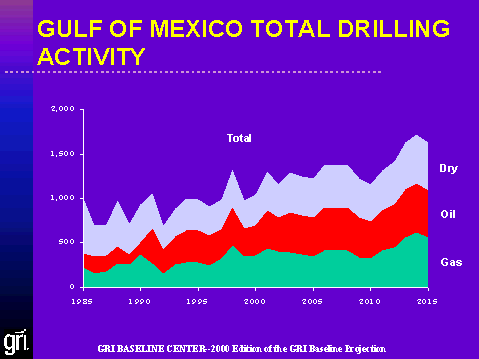
The basis of the projected increase in Gulf of Mexico production is, of course, increased drilling activity. However, because of the prolific nature of wells in the Gulf of Mexico (an offshore well can add 30 times more to reserves than a typical onshore well), drilling needs to grow steadily but not heroically.
This figure presents offshore drilling activity since 1985 and GRI’s projection through 2015. The data covers both exploratory and development wells for gas, oil, and dry holes, including recompletions. The total number of offshore wells is projected to increase from 1,300 in 1998 to 1,632 by 2015, near its peak level. Gas wells increase from 467 in 1998 to 552 by 2015 and oil wells increase from 206 in 1998 to 538 by 2015. Over the same period, the number of dry holes increases from 430 in 1998 to 540 by 2015. While the absolute number of dry holes increases, the percentage share drops from 39 percent of all wells in 1998 to 33 percent by 2015, indicating a sustained improvement in success rates.
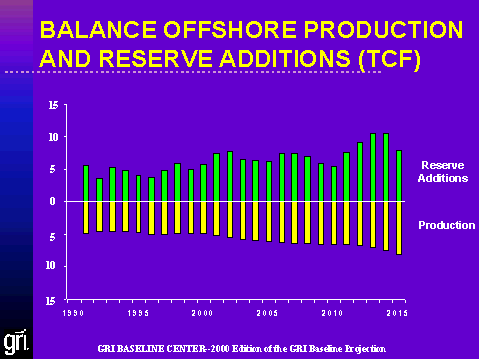
The result of the increase in drilling and the prolific nature of Gulf wells is that reserves increase more rapidly than production in the Gulf of Mexico which allows the absolute level of production to increase over time. This figure shows the historical and projected balance between reserve additions, on the top, and production, on the bottom. The figure illustrates that reserve additions fluctuate consistent with the boom and bust cycles in exploration activity resulting from price movements. On balance, reserve additions have exceeded production and this condition is projected to persist in the future and, in fact, expand due to contributions from deep and ultra-deep reserve additions. This growth in reserves allows production to gradually increase over the projection.
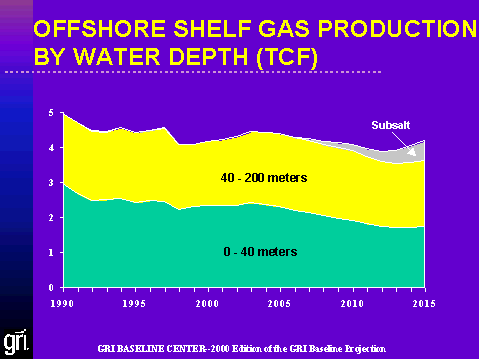
Much has been written about the accelerating decline in production from wells in the Gulf of Mexico. Much of this discussion is based on production data from wells on the shelf, the oldest producing area in the Gulf. There has been relatively limited activity on the slope and the deep waters of the Gulf. As this figure illustrates, there has been some erosion in shelf production, but the shelf has not collapsed. The attrition to date has largely been related to gas prices and small reservoir factors.
The 2000 projection expects some continued decline in shelf production. Most of the decline is expected in the 0-40 meter depth range. Production in that depth range is projected to decline by 0.6 Tcf between 1998 and 2015. For the most part, production from the 40-200 meter depth range is projected to hold relatively steady. Overlaying the entire offshore area is the subsalt play. A pick-up in subsalt production late in the projection provides helps to prop up shelf production. Subsalt production is projected to grow to nearly 0.6 Tcf annually by 2015.
Reduced drilling in the shallow waters during 1998 and 1999 due to the impact of low oil prices helped to create uncertainty. Reserve additions are the lifeblood of the shelf and they stem from drilling activity levels and ultimately the size of discoveries. A similar situation existed in 1992 when gas prices and rig counts plummeted; yet annual shelf production eventually recovered from that crisis. The 1999 downturn is expected to show a similar outcome when placed in the context of the big picture.
Today, shelf production is being maintained without a large increase in new gas well drilling. Although the offshore rig count was down in 1999, it was still nearly double the 1992 level. Producers have turned to innovative cost-effective measures to maintain production.
Furthermore, shelf producers can take comfort in the fact that technology developed in deepwater and ultra-deep waters will trickle down and find application in the shallow water, thereby reducing costs and extending shelf resource life. In addition, the emerging subsalt trend represents a fresh technological frontier that promises to extend shelf operations for additional years as success rates improve.
Also important, the 1990s marked the beginning of a transition period in offshore shelf operations. This transition is not unlike the situation during the 1980s when the major producers sold onshore properties to independent producers so they could focus on more “attractive” prospects. Today, a similar shift is occurring on the shelf. The independent producers are gradually taking over operation of production on the shelf. Through increased drilling activity, the reworking of existing wells, and more intensive production practices, it is anticipated that the independent producers can limit the decline in shelf production. Further, this transition allows the major producing companies to concentrate on the deepwater resources and to grow production from those areas. Incremental production from the deepwater of the Gulf of Mexico will build on top of continued shelf production providing for increased supply from the Gulf.
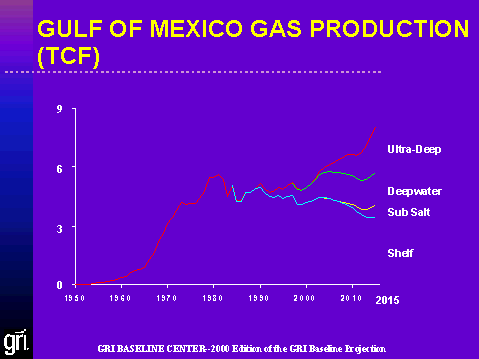
The Gulf of Mexico was once an untested supply area from which production continually expanded for 30 years. Then, beginning in the early 1980s and extending until today, production remained relatively level, near 5 Tcf. This figure illustrates historical production and GRI’s projection of production growth. As the figure illustrates, production from the deepwater and ultra-deep are major contributors to production growth in the Gulf that builds on the established base of production from the “shelf”. Total Gulf of Mexico gas production are projected to reach levels in excess of 8 Tcf by 2015. The Gulf of Mexico will account for 29 percent of incremental U.S. gas supply between 1998 and 2015. The largest single share of any resource area.
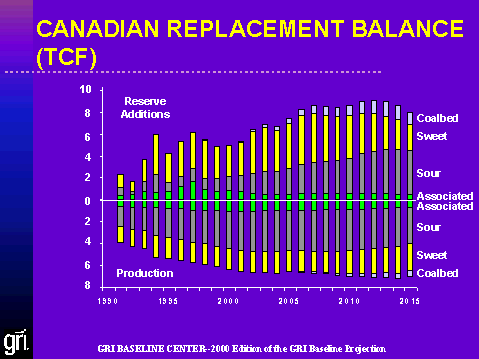
Turning to the second pillar of U.S. gas supply, Canadian imports. Like the U.S., Canadian production can only increase if reserve additions outpace production. This figure illustrate how the different types of reserve additions and production will contribute to supply. Shown are the various sources or types of gas. For Canada, these include sweet (conventional), sour (tight), coalbed methane, and associated gas. Of note, associated and sweet gas production is greater than reserve additions in later years. However, sour gas and coalbed methane reserve additions exceed production, providing the ability to not only sustain but increase production. In fact, Canadian reliance on production from sour gas and coalbed methane increases rapidly in the later years of the projection as sweet and associate gas production begin to decline.
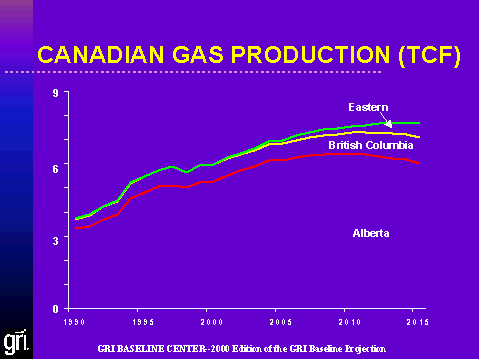
This figure shows projected growth in Canadian production by major region. Overall Canadian production grows to 7.7 Tcf by 2015. There is a sustained increase until about 2010 before aggregate Canadian production begins to flatten. Production from Alberta peaks at the 6 Tcf level by 2005. However, production growth in Eastern Canada and British Columbia offset any decline in Alberta production thereafter. Production from Eastern Canada is projected to grow by 0.6 Tcf while British Columbia adds another 0.4 Tcf. For Eastern Canada, reserve additions are on the order of four times annual production in the 2005 to 2010 timeframe.
One wild card in the Canadian supply picture is the frontier areas, particularly, the Mackenzie Delta, Fort Liard, and the Sable Island areas. Presently, the GRI projection incorporates only an increase in production from Eastern Canada, and that is modest compared to some estimates, and includes no production from the Mackenzie Delta, Fort Liard, or Sable Island. Once developed, these frontier areas have the potential to increase supply dramatically. As a result, Canadian production has the potential to increase beyond the level shown here.
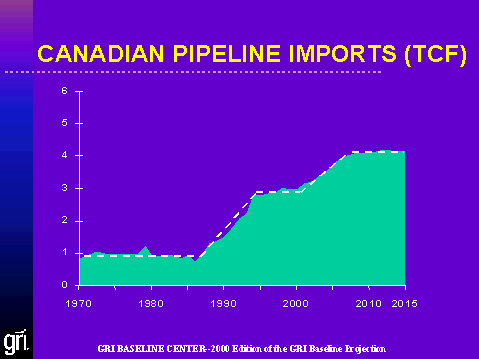
Fortunately for U.S. gas markets, the two most prolific supply sources in North America exist at both extremes of its borders: Canada on the north and the Gulf of Mexico on the south. This geographical relationship positions each resource equidistant from the key Northeast and Middle Atlantic gas demand markets. This positioning ensures that each supply region is in competition with the other to meet incremental supply requirements.
In the near term, pipeline imports from Canada are expected to increase steadily, growing from 3.0 Tcf in 1998 to more than 4.0 Tcf by 2007. Of particular note is the “stair step” pattern depicted by the dashed line. Canadian imports have traditionally been constrained by available pipeline export capacity. New pipeline capacity tends to become available in large chunks. The volumes needed to fill the new pipeline capacity represent a large percentage increase in Canadian production. Production grows gradually, filling the new pipeline capacity, and then flattens out until the next pipeline expansion can be justified. Presently, Canadian gas markets are in the midst of a pipeline building boom under which Canadian import capacity is increasing as various pipeline projects are finished. Once completed, history is likely to repeat itself and production will grow to fill the new lines.
At the turn of the century, net pipeline imports will account for almost 15 percent of total U.S. gas supply. By 2005, expanding imports will account for 17 percent of U.S. gas supply. After 2007, pipeline imports are expected to level off in a range of 4.0 to 4.2 Tcf. This “topping out” reflects limits on pipeline capacity (the next step as noted above) and stiff competition from growing lower-48 production, particularly the Gulf of Mexico, not resource constraints.
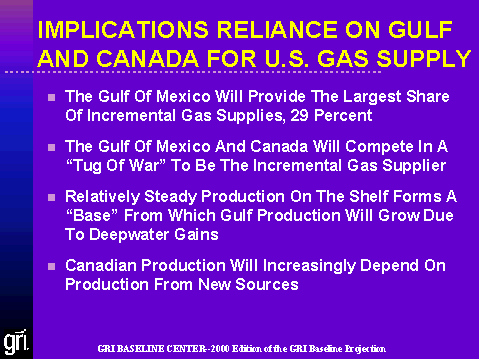
Gulf of Mexico production increases from 4.9 Tcf in 1998 to over 8 Tcf by 2015. The 3.2 Tcf growth in production represents the largest single source of incremental gas supply (29 percent of total supply growth) in North America. Meanwhile, Canadian production expands by 2 Tcf between 1998 and 2015 and is the next largest contributor to incremental North American gas supply accounting for 18 percent of new supply. Net Canadian imports to the U.S. increase by 1.3 Tcf during the projection period.
Owing to their location relative to the key Northeast and Middle Atlantic gas demand markets, these two prolific supply regions will be in continual competition to meet incremental supply requirements. The result of this competition will swing back and forth based on the availability of pipeline capacity, resource economics, and ultimately, price competition. However, the big winner will be the gas consumer who will be assured of a steady supply of gas and competitive gas prices.
Gas production on the Gulf of Mexico is not collapsing as some pundits have suggested. A distinction needs to be made between the shelf and other parts of the Gulf that are relatively unexplored. There has been some erosion in shelf production, but the attrition to date has largely been related to gas price and small reservoir factors. Further, what decline has occurred has been predominantly in the 0-40 meter depth range. For the most part, production from the 40-200 meter depth range is projected to hold relatively steady. Finally, a pick-up in subsalt production late in the projection provides support for shelf production. Instead of collapsing, Gulf of Mexico production is projected to grow steadily as shelf production provides a base from which deepwater production can grow.
Canadian production will increasingly depend on production from newer sources and areas such as coalbed methane, sour gas production, and Eastern Canada. Further, while not considered in the 2000 GRI baseline projection, growth in Canadian production could be greater as efforts are expanded into the Mackenzie Delta, Fort Liard, and the Sable Island areas.

One trend in American business that emerged during the 1990s is the practice of getting by on less resources--whether raw materials, finished goods, or labor--this means carrying less inventory and completing the product as close to the required delivery time as possible. Some use the term “just-in-time” to describe this operating practice. For example, railroads are delivering parts to factories at almost the precise instant they are needed on the assembly line. Automobile manufacturers are bringing new models to market quicker than ever by reducing product development cycle time. Microprocessors have allowed auto companies to create “virtual” cars, thereby eliminating defects before they exist at the prototype or manufactured stage. Likewise, auto industry suppliers have applied similar techniques to more quickly create the various new dies, jigs, and fixtures to move a design to the production stage. This practice has its risks and there is little margin for error. However, this trend is expected to persist.
The oil and gas industry is not any different. Producers are moving to similar just-in-time practices through less behind-the-pipe reserves (lower R/P Ratios), accelerated depletion of fields, and the reduction of the time from discovery to production. These changes have important implications for supply reliability and potentially for price volatility.
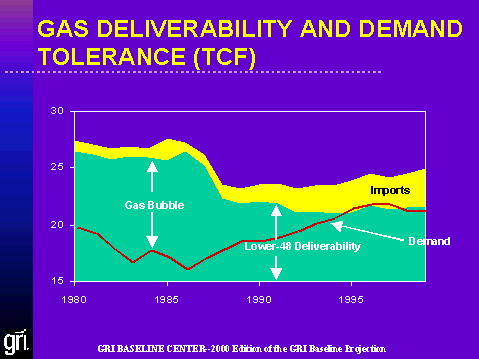
The road to a 30 Tcf demand market will be a continuation of the trend that began with the last market turn in 1986. However, as time has passed and demand has grown, the fundamental relationship between supply and demand has changed. The large gas supply overhang that existed during the 1980s, commonly known as the “gas bubble”, disappeared by the early 1990s. This convergence of supply and demand created a “pinch point” and prices firmed and became increasingly volatile. Since the early 1990s, gas markets have operated in virtual equilibrium with production and reserve additions generally tracking demand growth.
With gas markets in balance and with limited storage capability, supply must literally equal demand. Unlike petroleum markets, there is limited capability to inventory or store produced gas. Instead, at any point in time the “cushion” between demand and supply exists in the form of gas deliverability from lower-48 production and, to a lesser extent, imports from Canada. These two parameters combine to define the maximum potential for gas delivery to the market. Excess calls for supply will result in higher prices and declines in demand to levels below deliverability will result in lower prices. The difference between domestic demand and supply is the cushion or shortage (however, there can only be a shortage in theory since demand will be capped by available supply).
The balanced gas market of today creates different incentives than the situation in the 1980s and early 1990s. Therefore, a comparison of current data to historical statistics could be misleading without consideration of the changes that have taken place in the business climate and implied incentives. When the gas bubble overshadowed gas markets, there was no incentive for producers to provide more gas supply to the market. In fact, at the time, there was extensive talk of shutting-in gas production to improve the price for producers .
The gas bubble materialized because of business practices and federal regulations in the 1970s in both the U.S. and Canada. During that time, regulations stipulated that pipelines could not be built without substantial gas reserves being available and dedicated to their operation. Further, gas was viewed as being a scarce resource and consumption was discouraged in all but the most desirable applications. This resulted in a considerable overhang of unused delivery capacity. This was an accepted fact of business at the time. Reserve to production ratios (R/P) were sometimes as high as 40 years. In an anomaly arising from the way contracts were structured (“take-or-pay”), producers were guaranteed revenues from gas reserves whether pipeline customers took gas volumes or not.
Today, with the structural changes (price decontrol at the production end in the early 1980s and various FERC orders opening up the pipeline network), the R/P ratio has dropped to 8.4 years. The 1990s were a transition period in which the market went from a surplus to a balanced supply-demand market. With the gradual elimination of old beliefs, producers are now incentivized to increase gas production, sales, and revenues.

Over the past three decades, the R/P ratio has dropped from nearly 14 to 8.4 years. This decline is illustrated on this figure. However, gas consumption in 1998 is roughly 21.3 Tcf, almost identical to what it was in 1970. Given the lead-time necessary to turn new discoveries into production, how has production been maintained with a sharp drop in the inventory of gas available to the market?
Over this period, technology has allowed the gas industry to discover and produce gas quicker, thereby allowing producers to address growth in supply requirements more rapidly, and eliminating the need for large unproduced inventories as existed in the past. The best measure of industries heightened ability to bring new gas to market is by the reduction in cycle time, that is, the time between first discovery and first production of new gas resources.
This exhibit illustrates the improvement in gas industry cycle time as measured by offshore deepwater activity, one of the most severe environments for exploration. The offshore is an area where application of technology is critical and results are readily evident. A scatter diagram is shown illustrating the decline in time required between 1975 and 1998 to advance a deepwater offshore discovery to first production. The various projects, and their lead times, are depicted by the dots. A trend line is drawn through this data to highlight the decline. The trend line suggests that the typical cycle time has been reduced from 12 years, in the mid 1970s, to around 5 years today. It is this type of improvement in performance that has allowed the gas industry to operate without as large an unproduced inventory cushion as existed in the past.
However, with the decline in cycle time and the improved ability to meet demand with lower R/P ratios, price volatility has increased as the balance between supply and demand has become tighter. The tightness of markets has reduced the margin of error and increased the cost of supply shortfalls. Price volatility increased throughout the early 1990s and reached a maximum in 1996 when some daily prices spiked by a factor of 10 times the customary price. Although the degree of volatility has not grown since 1996, increased price volatility is expected to persist in the future.
Just how low can inventories, as measured by R/P ratio, decline? GRI sees R/P ratios declining to 7.5 years by 2015. This represents a reduction of 12 percent for the lower-48. As long as the cycle time is equal to the R/P ratio, reserve additions need only match annual production to maintain current demand levels. To the extent the cycle time is reduced to less than the R/P ratio, reserves can grow or production can grow. A declining R/P ratio does not necessarily reflect a decline in the resource base, but more a desirable acceleration in the timing between discovery and production.
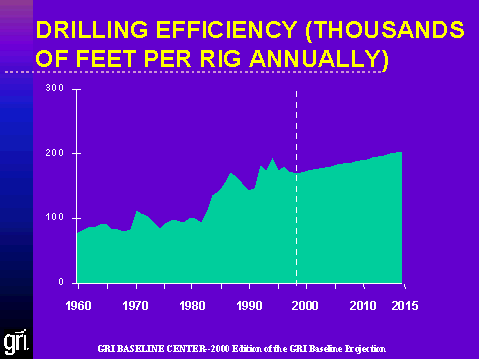
The basis of the improvement in cycle time and the ability for R/P ratios to continue to decline, while meeting growing supply requirements, is improvement in technology. As an example, this figure illustrates the trend in average annual footage drilled by active rigs over the past four decades. The upward trend in drilling efficiency is obvious. In fact, the typical rig of today drills the total footage of two rigs in the early 1970s. This growth trend is anticipated to continue over the projection, and will be supported by technology advances that increase returns per unit of effort applied. The projected trend appears reasonable in the context of the previous demonstrated historical trend.
Part of the explanation for these efficiency gains is that technology has allowed drillers to “work smarter.” Guided by 3-D seismic, drillers are able to better home in on their target the first time. Using better-matched drilling mud and bits for the particular application has reduced inefficiencies. Improved drilling bits and fluids have also increased penetration rates, saving time. Further, improved bit life has often eliminated the incremental bit trip and the resultant delay and lost time. The cumulative result of these advances is a reduction in the number of drilling days.
Continued improvements in rig efficiency also lessen the requirement on the rig count over time. By 2015, the average annual footage drilled per rig is projected to increase by nearly 20 percent.
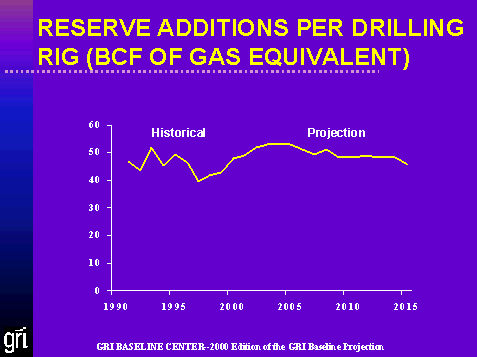
This figure presents another way of looking at drilling rig efficiency in the context of successful efforts. We have noted elsewhere that drilling efficiency as measured on a per rig per thousand foot basis annually has been improving and is projected to increase by at least another 20 percent. The question arises as to how well these efficiency gains are being translated into fulfilling supply?
This figure presents a measure of oil and gas reserve additions. The oil component has been translated into equivalent units of natural gas expressed in Bcf to characterize total results from both energy components and overall drilling activity. Until a successful well is tested and completed, one does not know for certain which, or how much, product has been discovered. The line represents these total annual oil and gas reserve additions divided by the corresponding rig count to derive a Bcf-equivalent return per each rig. As shown, this return is projected to remain in a range of 45 to 50 Bcf of gas equivalent for each rig. This is in line with historical experience, but represents somewhat of an improvement over most recent experience in the late 1990s. This improvement is projected to continue until it peaks in 2004. The strong reserve addition performance in the Gulf of Mexico for both oil and gas discoveries is responsible for influencing this near-term gain.
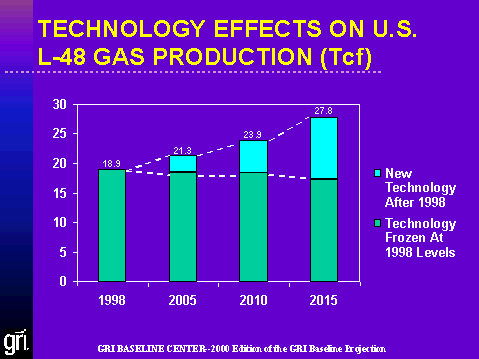
This figure was presented earlier. However, it is presented again to summarize the impact of technology from the producers’ perspective.
One lesson that producers have learned is that end users are indifferent to the origins of gas and will not pay a premium price, no matter how exotic the source. This is in spite of the higher costs that producers must bear when seeking out non-conventional sources. Technology allows drilling to take place where the best economic benefit can occur for both the producer and consumer. Technology substitutes for price. It is the application of this benefit that allows gas production to expand.
New technology provides the production techniques that make it possible to accelerate production from a given well. Such accelerated flow rates allow producers to maximize the present value of expected revenues and this immediately translates to their bottom line.
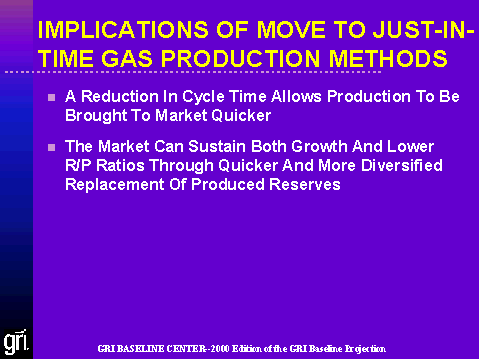
Technology will be the facilitator to allow industry to add reserves for each source and type of gas identified. Non-conventional sources will increase in both volume and percentage of total supply. Since non-conventional resources are widely dispersed by geography, regional and economic factors will influence the timing of their arrival.
Application of advanced technologies will allow industry to achieve higher success rates and drill deeper despite the obstacles of higher costs. On a simplistic basis, deeper reservoirs generally correlate with greater reserves. There will also be more increased use of infield drilling and 4-D seismic to recover greater quantities of the known reserves in a field. Offshore, a transition to deeper waters will add incremental supply. Shortening cycle times (particularly offshore) will allow industry to cut costs and bring supply to market quicker to better match demand growth.
What these factors indicate collectively is a continuing fundamental shift in gas exploration and production practices in the industry. Improvement in cycle time allows new discoveries to be brought to market quicker. This allows the market to sustain growth with lower R/P ratios arising from more diversified replacement of reserves.
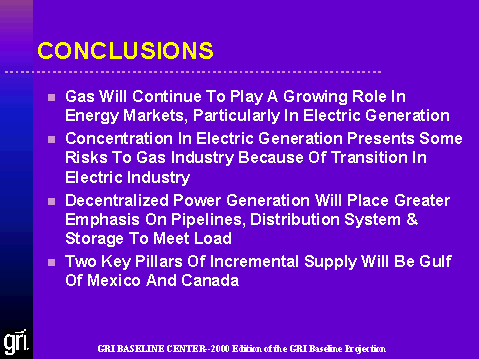


The 2000 Edition of the GRI Baseline Projection describes a highly competitive, low-price energy world in which gas is not only able to compete but expands its share of U.S. energy consumption. Critical to the achievement of this outlook is success in the development and utilization of new gas technologies: end-use technologies that improve the efficiency of gas use and allow gas to enter new markets; supply technologies that increase the gas yield per unit of effort; and gas operations technologies that enhance the efficiency of serving markets by better utilizing both pipeline and storage capacity.
While gas demand grows in all sectors, over 50 percent of the growth is for electric power generation. This is a consistent theme that runs through many contemporary projections. This perspective growth includes risk for the gas industry. The electric power industry is in a state of transition from an industry dominated by regulated utilities using large centralized power plants to a deregulated power industry relying on decentralized smaller sized power plants. The degree of change in this size of a transition creates investment requirements and costs for all suppliers of the transitioning industry, including the natural gas industry. The supplying industries need to adjust their service as the customer changes. The changes taking place in the electric industry are likely to place a greater emphasis on distribution and storage services as the average size of the generating plant declines, the number of facilities increase, and the geographic dispersion grows. The cost of serving a larger number of generating units and customers is likely to be greater to the gas industry and the mix of services required will be broader.
Two key pillars in meeting incremental gas supply requirements will be increased production from the Gulf of Mexico and Canada. Increased supply from the deep waters of the Gulf will build on continued production from the shelf. Contrary to the opinion of some pundits, shelf production will not decline catastrophically. Total Gulf production is likely to reach levels of 8 Tcf or more by 2015 (versus 5 Tcf in 1998) accounting for almost 30 percent of all growth in combined lower-48 and Canadian supply.
Canadian production will expand by roughly 2 Tcf between 1998 and 2015. It will be the second largest contributor to growth in combined lower-48 and Canadian supply, accounting for almost 20 percent of growth. As a result of this growth, U.S. imports will grow by 1.3 Tcf. Canadian production will increasingly depend on production from new sources and areas such as coalbed methane, sour (tight) gas production, and Eastern Canada. Further, the potential exists for the further expansion of Canadian gas production from the Mackenzie Delta and Sable Island areas that are not considered in the 2000 edition of the baseline projection.
Out of necessity, the gas E&P business has gradually moved to the equivalent of just-in-time operating practices. This change in operation practice implies less behind-the-pipe reserves (lower R/P ratios), accelerated depletion of fields, and a reduction of the time from discovery to production. This approach allows producers to minimize risk and more quickly monetize their in ground resources.
The move to just-in-time production methods carries with it some risk of price volatility as supply tightens (better balance between supply and demand). Tighter supply reduces the margin for error and increases the cost of supply shortfalls, leading to price volatility. Price volatility increased throughout the 1990s and is expected to persist in the future. The benefit from this approach is that it allows growth in supply to be sustained with a cut in costs for consumers and producers.
Overall, the 2000 Edition of the GRI Baseline Projection expects that the expansion in gas markets experienced over the last decade can and will be continued over the long term. Critical to this expansion is continued technology improvement that offers a way to leverage industry investment and activity.
General
Crude Oil Prices
| - Nominal Prices | - Real Prices (1998$) |
| * Nominal prices grow:
21.4%/year, 1998-2000
|
* Real prices grow:
19.0%/year, 1998-2000
|
| * Nominal RAC Price:
1996: $20.71/barrel
|
* Real RAC Price:
1996: $21.35 barrel
|
Gross Domestic Product
| 1997 | 1998 | 2000 | 2005 | 2010 | 2015 | ||
| Natural Gas | |||||||
| Residential | 6.82 | 6.60 | 6.59 | 6.06 | 5.70 | 5.27 | |
| Commercial | 5.74 | 5.40 | 5.55 | 5.09 | 4.77 | 4.42 | |
| Industrial | 3.49 | 3.15 | 3.33 | 3.05 | 2.89 | 2.78 | |
| Interruptible | 2.70 | 2.33 | 2.53 | 2.36 | 2.25 | 2.26 | |
| Firm | 4.03 | 3.70 | 3.86 | 3.53 | 3.33 | 3.14 | |
| Electric Generation | 2.79 | 2.41 | 2.73 | 2.58 | 2.44 | 2.46 | |
| Interruptible | 2.54 | 2.22 | 2.43 | 2.38 | 2.26 | 2.33 | |
| Firm | 2.92 | 2.51 | 2.89 | 2.70 | 3.55 | 2.54 | |
| Electricity | |||||||
| Residential | 25.36 | 24.45 | 24.37 | 24.16 | 23.30 | 22.04 | |
| Commercial | 22.49 | 22.69 | 22.44 | 22.22 | 20.30 | 20.05 | |
| Industrial | 13.62 | 13.88 | 13.56 | 12.79 | 10.70 | 9.98 | |
| Coal | |||||||
| Industrial | 1.51 | 1.45 | 1.37 | 1.27 | 1.20 | 1.16 | |
| Electric Generation | 1.33 | 1.29 | 1.22 | 1.13 | 1.08 | 1.05 | |
| Petroleum | |||||||
| Distillate | |||||||
| Residential | 7.27 | 6.02 | 7.22 | 7.32 | 7.42 | 7.52 | |
| Commercial | 5.35 | 4.10 | 5.30 | 5.40 | 5.50 | 5.60 | |
| Industrial | 5.55 | 4.29 | 5.50 | 5.60 | 5.69 | 5.79 | |
| Electric Generation | 4.86 | 3.39 | 4.76 | 4.80 | 4.88 | 4.99 | |
| Residual | |||||||
| Industrial | 3.49 | 2.71 | 3.22 | 3.16 | 3.14 | 3.12 | |
| Electric Generation | 3.24 | 2.39 | 3.24 | 3.13 | 3.14 | 3.31 | |
Table 4
U.S. Primary Energy Consumption in the 2000 Edition of the GRI Baseline
Projection
(Quads)
|
|
||||||
| 1997 | 1998 | 2000 | 2005 | 2010 | 2015 | |
| Petroleum | 36.3 | 36.6 | 37.5 | 40.1 | 42.0 | 43.8 |
| Gasa | 22.5 | 21.8 | 22.9 | 26.3 | 29.3 | 33.5 |
| (Total Gas Fuels)b | (22.6) | (21.9) | (23.1) | (26.4) | (29.5) | (33.7) |
| Coal | 21.5 | 21.7 | 21.6 | 22.2 | 24.4 | 25.4 |
| Nuclear | 6.7 | 7.2 | 7.5 | 7.4 | 7.1 | 5.9 |
| Hydro | 3.8 | 3.4 | 3.3 | 3.4 | 3.5 | 3.5 |
| Otherc | 3.6 | 3.6 | 3.6 | 4.1 | 5.1 | 5.6 |
| Total | 94.4 | 94.4 | 96.4 | 103.5 | 111.4 | 117.7 |
a Excludes synthetic gas from petroleum and coal.
b The 2000 edition of the projection includes 0.1 quad of "other" gas,
primarily SNG from petroleum and miscellaneous gases, and high Btu coal
gas, in 2000 and 0.2 quad in 2005, 2010, and 2015, respectively.
c Includes geothermal, municipal solid waste, wood, other biomass,
solar thermal, solar photovoltaic, wind, etc.
Table 5
U.S. Energy Consumption by Sector in the 2000 Edition of the GRI
Baseline Projection
(Quads)
|
|
||||||
| 1997 | 1998 | 2000 | 2005 | 2010 | 2015 | |
| Residential | 10.9 | 10.4 | 11.1 | 11.6 | 12.2 | 12.9 |
| Commercial | 7.7 | 7.5 | 8.0 | 8.5 | 9.2 | 9.8 |
| Industrial | 28.1 | 27.5 | 28.1 | 30.2 | 32.7 | 35.1 |
| Transportation | 24.8 | 25.2 | 25.8 | 28.0 | 29.7 | 31.0 |
| Total Delivered | 71.5 | 70.6 | 73.0 | 78.3 | 83.8 | 88.8 |
| Net Lossesa | 22.9 | 23.8 | 23.4 | 25.2 | 27.5 | 28.9 |
| Total Primary | 94.4 | 94.4 | 96.4 | 103.5 | 111.4 | 117.7 |
a Primarily losses in electrical generation and transmission and coal gasification.
Table 6
Delivered Energy Consumption in the 2000 Edition of the GRI Baseline
Projection
Residential Sector
(Quads)
|
|
||||||
| 1997 | 1998 | 2000 | 2005 | 2010 | 2015 | |
| Petroleum | 1.4 | 1.2 | 1.3 | 1.3 | 1.2 | 1.2 |
| Gas | 5.1 | 4.6 | 5.1 | 5.3 | 5.6 | 5.8 |
| Coal | 0.1 | 0.1 | 0.1 | 0.1 | a | a |
| Electricity | 3.7 | 3.8 | 4.0 | 4.4 | 4.9 | 5.4 |
| Otherb | 0.6 | 0.6 | 0.6 | 0.5 | 0.5 | 0.4 |
| Total | 10.9 | 10.4 | 11.1 | 11.6 | 12.2 | 12.9 |
a Less than 0.05 quad.
b Includes wood, solar, and other.
Table 7
Energy Consumption By Type Of Service
in the 2000 Edition of the GRI Baseline Projection
Residential Sector
(Trillion Btu)
| 1998 | 2000 | 2005 | 2010 | 2015 | % Change
1998 to 2015 |
||||||||
| Natural Gas | |||||||||||||
| Space Heating | 2938 | 3356 | 3410 | 3485 | 3574 | 1.2 | |||||||
| Water Heating | 1322 | 1356 | 1449 | 1536 | 1633 | 1.2 | |||||||
| Cooking | 156 | 156 | 158 | 158 | 157 | 0.1 | |||||||
| Clothes Dryers | 61 | 64 | 69 | 75 | 82 | 1.7 | |||||||
| Space Cooling | 7 | 7 | 7 | 8 | 9 | 1.7 | |||||||
| Hearth Products | 102 | 128 | 200 | 270 | 341 | 7.4 | |||||||
| Other | 30 | 31 | 33 | 35 | 37 | 1.2 | |||||||
| Total Natural Gas | 4616 | 5097 | 5326 | 5567 | 5833 | 1.4 | |||||||
| Electricity | |||||||||||||
| Space Heating | 749 | 855 | 877 | 920 | 952 | 1.4 | |||||||
| Space Cooling | 755 | 690 | 739 | 771 | 846 | 0.7 | |||||||
| Water Heating | 530 | 549 | 587 | 651 | 712 | 1.8 | |||||||
| Refrigerators | 415 | 414 | 402 | 391 | 396 | -0.3 | |||||||
| Home Freezers | 99 | 98 | 92 | 96 | 107 | 0.4 | |||||||
| Cooking | 136 | 142 | 154 | 168 | 183 | 1.8 | |||||||
| Microwave Ovens | 34 | 37 | 42 | 47 | 52 | 2.5 | |||||||
| Clothes Dryers | 171 | 183 | 201 | 226 | 256 | 2.4 | |||||||
| Clothes Washers | 26 | 27 | 29 | 30 | 31 | 1.1 | |||||||
| Dishwashers | 28 | 29 | 31 | 33 | 35 | 1.2 | |||||||
| Lighting | 299 | 315 | 353 | 387 | 423 | 2.1 | |||||||
| Other | 594 | 673 | 919 | 1188 | 1375 | 5.1 | |||||||
| Total Electricity | 3835 | 4010 | 4425 | 4907 | 5367 | 2.0 | |||||||
| Oil | |||||||||||||
| Space Heating | 1003 | 1100 | 1034 | 980 | 930 | -0.4 | |||||||
| Water Heating | 141 | 131 | 125 | 122 | 122 | -0.8 | |||||||
| Cooking | 23 | 23 | 22 | 21 | 20 | -0.6 | |||||||
| Other | 78 | 82 | 88 | 95 | 101 | 1.5 | |||||||
| Total Oil | 1244 | 1335 | 1268 | 1217 | 1174 | -0.3 | |||||||
Table 8
Delivered Energy Consumption
in the 2000 Edition of the GRI Baseline Projection
Commercial Sector
(Quads)
|
|
||||||
| 1997 | 1998 | 2000 | 2005 | 2010 | 2015 | |
| Petroleum | 0.7 | 0.7 | 0.7 | 0.6 | 0.6 | 0.5 |
| Gasa | 3.3 | 3.1 | 3.4 | 3.6 | 3.9 | 4.3 |
| Coal | 0.1 | 0.1 | 0.1 | 0.1 | 0.1 | 0.1 |
| Electricityb | 3.5 | 3.6 | 3.8 | 4.2 | 4.6 | 4.9 |
| (Cogenerated Elec.)c | e | e | e | (0.1) | (0.1) | (0.1) |
| Otherd | 0.1 | 0.1 | 0.1 | 0.1 | 0.1 | 0.1 |
| Total | 7.7 | 7.5 | 8.0 | 8.5 | 9.2 | 9.8 |
a Includes gas consumed in commercial cogeneration.
b Includes only purchased electricity.
c The primary energy consumed to produce cogenerated electricity has
already been included in the totals for gas, petroleum, and coal consumption.
This total reflects only the electricity produced and used onsite from
commercial cogeneration and engine generators.
d Includes wood, biomass, solar, and other.
e Less than 0.05 quad.
Table 9
Energy Consumption By Type Of Service
in the 2000 Edition of the GRI Baseline Projection
Commercial Sector
(Trillion Btu)
|
% Change
|
||||||
| 1998 | 2000 | 2005 | 2010 | 2015 |
1998 to 2015
|
|
| Natural Gas | ||||||
| Space Heating | 1693 | 1924 | 1916 | 1936 | 1919 | 0.7 |
| Space Cooling | 123 | 119 | 188 | 301 | 439 | 7.8 |
| Water Heating | 459 | 474 | 511 | 548 | 579 | 1.4 |
| Cooking | 339 | 343 | 363 | 392 | 419 | 1.2 |
| Clothes Dryers | 179 | 185 | 196 | 208 | 216 | 1.1 |
| Other | 192 | 196 | 201 | 208 | 210 | 0.5 |
| Power Generation | 159 | 168 | 214 | 310 | 477 | 6.7 |
| Cogeneration | (156) | (162) | (196) | (259) | (334) | (4.6) |
| Other Generation | (3) | (6) | (18) | (50) | (143) | (24.6) |
| Total Natural Gas | 3145 | 3409 | 3589 | 3903 | 4258 | 1.8 |
| Electricity | ||||||
| Space Heating | 292 | 335 | 332 | 338 | 333 | 0.8 |
| Space Cooling | 747 | 727 | 789 | 815 | 791 | 0.3 |
| Water Heating | 146 | 149 | 150 | 152 | 146 | 0.0 |
| Ventilation | 197 | 204 | 215 | 231 | 240 | 1.2 |
| Lighting | 1456 | 1516 | 1639 | 1785 | 1884 | 1.5 |
| Cooking | 84 | 89 | 99 | 112 | 125 | 2.4 |
| Clothes Dryers | 34 | 37 | 44 | 52 | 60 | 3.3 |
| Refrigeration | 154 | 159 | 171 | 182 | 191 | 1.3 |
| Other | 505 | 584 | 781 | 1014 | 1259 | 5.5 |
| Total Electricity | 3615 | 3801 | 4219 | 4682 | 5031 | 2.0 |
| Purchased | (3579) | (3761) | (4163) | (4596) | (4892) | (1.9) |
| Cogen Electric | (36) | (40) | (56) | (85) | (139) | (8.2) |
| Oil | ||||||
| Space Heating | 474 | 484 | 439 | 400 | 364 | -1.5 |
| Water Heating | 137 | 132 | 126 | 121 | 116 | -1.0 |
| Cooking | 12 | 12 | 11 | 11 | 10 | -1.0 |
| Other | 30 | 30 | 31 | 32 | 32 | 0.5 |
| Power Generation | 8 | 8 | 8 | 8 | 9 | 0.8 |
| Total Oil | 659 | 665 | 614 | 572 | 531 | -1.3 |
| Coal | ||||||
| Other | 65 | 65 | 62 | 60 | 57 | -0.8 |
| Power Generation | 15 | 15 | 14 | 14 | 13 | -0.7 |
| Total Coal | 80 | 79 | 76 | 73 | 70 | -0.8 |
Table 10
Delivered Energy Consumption
in the 2000 Edition of the GRI Baseline Projection
Industrial Sector
(Quads)
|
|
||||||
| 1997 | 1998 | 2000 | 2005 | 2010 | 2015 | |
| Petroleum | 9.3 | 9.1 | 9.3 | 10.0 | 10.9 | 12.0 |
| Gasa | 10.1 | 9.8 | 10.1 | 11.1 | 12.2 | 13.0 |
| Coal | 2.7 | 2.6 | 2.6 | 2.5 | 2.4 | 2.3 |
| Electricityb | 3.5 | 3.6 | 3.6 | 4.0 | 4.5 | 5.0 |
| (On-Site Gen--Self Use)c | (0.6) | (0.6) | (0.6) | (0.7) | (0.7) | (0.8) |
| (On Site Gen—Sales)d | (0.5) | (0.5) | (0.5) | (0.6) | (0.6) | (0.6) |
| Othere | 2.5 | 2.5 | 2.5 | 2.6 | 2.7 | 2.8 |
| Total | 28.1 | 27.5 | 28.1 | 30.2 | 32.7 | 35.1 |
a Includes gas consumed in on-site industrial power generation.
b Includes only purchased electricity.
c Reflects only the electricity produced in a cogeneration system that
is used onsite.
d Reflects only the electricity produced in a cogeneration system that
is sold to utilities for resale to end-use customers.
e Includes wood, solar, and direct hydroelectric generation.
Table 11
Industrial Fuel and Power Consumptiona
in the 2000 Edition of the GRI Baseline Projection
(Quads)
|
|
||||||
| 1997 | 1998 | 2000 | 2005 | 2010 | 2015 | |
| Petroleum | 4.2 | 4.1 | 4.0 | 4.1 | 4.3 | 4.6 |
| Gas | 9.3 | 9.0 | 9.3 | 10.3 | 11.3 | 12.1 |
| Coal | 1.8 | 1.7 | 1.7 | 1.5 | 1.5 | 1.4 |
| Electricityb | 3.5 | 3.6 | 3.6 | 4.0 | 4.5 | 5.0 |
| (On-Site Gen—Self Use)c | (0.6) | (0.6) | (0.6) | (0.7) | (0.7) | (0.8) |
| (On Site Gen--Sales)d | (0.5) | (0.5) | (0.5) | (0.6) | (0.6) | (0.6) |
| Othere | 2.5 | 2.5 | 2.5 | 2.6 | 2.7 | 2.8 |
| Total | 21.4 | 20.9 | 21.2 | 22.6 | 24.3 | 25.9 |
a Excludes industrial raw materials and feedstock energy consumption.
Delivered fuel totals include energy consumed in industrial cogeneration.
b Includes only purchased electricity.
c Reflects only the electricity produced in a cogeneration system that
is used onsite.
d Reflects only the electricity produced in a cogeneration system that
is sold to utilities for resale to end-use customers.
e Includes wood, solar, and direct hydroelectric generation.
Table 12
Energy Consumption By Type Of Service
in the 2000 Edition of the GRI Baseline Projection
Industrial Sector
(Trillion Btu)
| % Change | ||||||||||||
| 1998 | 2000 | 2005 | 2010 | 2015 | 1998 to 2015 | |||||||
| Natural Gas | ||||||||||||
| Boilers | 2361 | 2453 | 2580 | 2692 | 2633 | 0.6 | ||||||
| Power Generation | 2132 | 2187 | 2443 | 2661 | 2802 | 1.6 | ||||||
| Process Heat | 2648 | 2809 | 3201 | 3615 | 4031 | 2.5 | ||||||
| HVAC | 580 | 607 | 712 | 833 | 949 | 2.9 | ||||||
| Lease & Plant | 1281 | 1276 | 1378 | 1510 | 1702 | 1.7 | ||||||
| Feedstocks | 760 | 766 | 815 | 856 | 885 | 0.9 | ||||||
| Total Natural Gas | 9762 | 10098 | 11128 | 12168 | 13002 | 1.7 | ||||||
| Oil | ||||||||||||
| Boilers | 1144 | 1018 | 970 | 963 | 1063 | -0.4 | ||||||
| Power Generation | 100 | 103 | 119 | 121 | 123 | 1.2 | ||||||
| Process Heat | 1614 | 1642 | 1676 | 1727 | 1757 | 0.5 | ||||||
| Off-Highway | 1172 | 1228 | 1354 | 1484 | 1598 | 1.8 | ||||||
| HVAC | 20 | 22 | 25 | 28 | 30 | 2.2 | ||||||
| Feedstocks | 5002 | 5269 | 5881 | 6603 | 7399 | 2.3 | ||||||
| Total Oil | 9052 | 9282 | 10025 | 10927 | 11970 | 1.7 | ||||||
| Electricity | ||||||||||||
| Process Heat | 493 | 518 | 611 | 693 | 798 | 2.9 | ||||||
| Process Cooling | 115 | 116 | 125 | 142 | 159 | 1.9 | ||||||
| HVAC | 256 | 257 | 294 | 338 | 383 | 2.4 | ||||||
| Machine Drive | 2967 | 2977 | 3206 | 3561 | 3920 | 1.7 | ||||||
| Other Electric | 363 | 371 | 426 | 484 | 547 | 2.4 | ||||||
| Total Electricity | 4195 | 4240 | 4662 | 5218 | 5807 | 1.9 | ||||||
| Coal | ||||||||||||
| Boilers | 552 | 526 | 382 | 295 | 227 | -5.1 | ||||||
| Power Generation | 955 | 941 | 917 | 914 | 914 | -0.3 | ||||||
| Process Heat | 219 | 209 | 236 | 261 | 273 | 1.3 | ||||||
| Feedstocks | 921 | 919 | 917 | 910 | 901 | -0.1 | ||||||
| Total Coal | 2649 | 2595 | 2451 | 2380 | 2315 | -0.8 | ||||||
Table 13
Energy Consumption to Generate Electricity
in the 2000 Edition of the GRI Baseline Projectiona
(Quads)
|
|
||||||
| 1997 | 1998 | 2000 | 2005 | 2010 | 2015 | |
| Petroleum | 0.9 | 1.2 | 1.1 | 1.1 | 0.7 | 0.8 |
| Gas | 3.3 | 3.7 | 3.7 | 5.4 | 6.6 | 8.9 |
| Coal | 18.6 | 18.8 | 18.8 | 19.6 | 21.8 | 22.8 |
| Nuclear | 6.7 | 7.2 | 7.5 | 7.4 | 7.1 | 5.9 |
| Hydro | 3.6 | 3.3 | 3.2 | 3.3 | 3.3 | 3.3 |
| Otherb | 0.6 | 0.6 | 0.6 | 1.1 | 2.0 | 2.5 |
| Total | 33.6 | 34.8 | 34.9 | 37.8 | 41.6 | 44.2 |
| Electricity Generation | 11.6 | 12.1 | 12.4 | 13.6 | 15.1 | 16.4 |
| Utility Generated | 10.7 | 11.0 | 10.1 | 8.9 | 8.6 | 8.1 |
| Independent Power Producers | 0.3 | 0.6 | 1.7 | 4.0 | 5.7 | 7.2 |
| Industrial /Commercial
Power Purchases |
0.5 | 0.5 | 0.5 | 0.6 | 0.6 | 0.6 |
| Distributed Generation | c | c | c | C | 0.1 | 0.3 |
| Canadian Imports | 0.1 | 0.1 | 0.1 | 0.1 | 0.1 | 0.1 |
| less: Lossesd | 0.8 | 1.1 | 1.0 | 1.0 | 1.1 | 1.1 |
| Total Delivered Electricitye | 10.7 | 11.0 | 11.4 | 12.6 | 14.0 | 15.3 |
a Includes energy consumed by utilities and independent power generators.
The energy consumed by commercial and industrial power generators is included
in those sectors.
b Includes geothermal, municipal solid waste, solar thermal, solar
photovoltaic, wind, and wood/other biomass.
c Less than 0.1 quad.
d Losses in the transmission and distribution of electricity.
e “Delivered electricity” refers only to electricity purchased from
electric utilities, it does not include on-site generation for self-use.
Table 14
Natural Gas Consumption to Generate Electricity
in the 2000 Edition of the GRI Baseline Projection
(Quads)
|
|
||||||
| 1997 | 1998 | 2000 | 2005 | 2010 | 2015 | |
| Central Electric Utilities | 3.0 | 3.3 | 1.7 | 1.1 | 0.9 | 0.9 |
| Merchant/Independent Power Generators | 0.3 | 0.3 | 1.9 | 4.2 | 5.4 | 7.1 |
| Large Non-Central Power Generatorsa | 1.4 | 1.4 | 1.5 | 1.5 | 1.6 | 1.7 |
| (Industrial) | (1.2) | (1.3) | (1.3) | (1.3) | (1.4) | (1.4) |
| (Commercial) | (0.2) | (0.2) | (0.2) | (0.2) | (0.3) | (0.3) |
| Distributed Generation | 0.1 | 0.1 | 0.1 | 0.3 | 0.6 | 1.2 |
| (Utility) | ( b ) | ( b ) | ( b ) | ( b ) | ( 0.1) | (0.3) |
| (Merchant/IPG) | ( b ) | ( b ) | ( b ) | ( b ) | ( 0.1) | (0.4) |
| (Industrial) | (0.1) | (0.1) | (0.1) | (0.3) | (0.3) | (0.4) |
| (Commercial) | ( b ) | ( b ) | ( b ) | ( b ) | (0.1) | (0.1) |
| Total | 4.8 | 5.2 | 5.3 | 7.2 | 8.5 | 11.0 |
| (Tcf) | (4.6) | (5.0) | (5.1) | (7.0) | (8.3) | (10.8) |
a Includes large cogenerators and other generators (greater than 25
MW) in the commercial and industrial sectors. The energy total shown in
the table reflects the energy input in a cogeneration system attributable
to the generation of electricity only. This accounts for about two-thirds
of the energy input in a cogeneration system.
b Less than 0.1 quad.
Table 15
Delivered Energy Consumption
in the 2000 Edition of the GRI Baseline Projection
Transportation Sector
(Quads)
| Actual | ||||||
| 1997 | 1998 | 2000 | 2005 | 2010 | 2015 | |
| Petroleum | 24.0 | 24.4 | 25.0 | 27.0 | 28.4 | 29.3 |
| Gas | 0.8 | 0.7 | 0.8 | 1.0 | 1.3 | 1.7 |
| (Vehicles) | ( a ) | ( a ) | ( a ) | (0.1) | (0.3) | (0.6) |
| (Pipeline) | (0.8) | (0.7) | (0.8) | (0.9) | (1.0) | (1.1) |
| Electricityb | ( a ) | ( a ) | ( a ) | ( a ) | ( a ) | ( a ) |
| Total | 24.8 | 25.2 | 25.8 | 28.0 | 29.7 | 31.0 |
a Less than 0.05 quad.
b Includes electricity used by railroads and vehicles.
Table 16
Passenger Car Assumptions
in the 2000 Edition of the GRI Baseline Projection
|
& Change
|
||||||
| 1998 | 2000 | 2005 | 2010 | 2015 |
1998 to 2015
|
|
| Stocks (Millions) | 120.9 | 120.3 | 118.0 | 115.7 | 112.6 | -0.4 |
| Miles Traveled (Billions) | 1,371 | 1,376 | 1,410 | 1,429 | 1,455 | 0.3 |
| Miles per Car | 11,354 | 11,451 | 12,007 | 12,475 | 13,107 | 0.8 |
| Miles per Driver | 6,613 | 6,506 | 6,355 | 6,144 | 6,004 | -0.6 |
| Stock Average (MPG) | 21.5 | 21.9 | 22.9 | 24.7 | 27.1 | 1.4 |
Table 17
Gas Demand by Sector
in the 2000 Edition of the GRI Baseline Projection
(Quads)
|
|
||||||
| 1997 | 1998 | 2000 | 2005 | 2010 | 2015 | |
| Residential | 5.1 | 4.6 | 5.1 | 5.3 | 5.6 | 5.8 |
| Commerciala | 3.3 | 3.1 | 3.4 | 3.6 | 3.9 | 4.3 |
| Industriala | 10.1 | 9.8 | 10.1 | 11.1 | 12.2 | 13.0 |
| Electric Generationb | 3.3 | 3.7 | 3.7 | 5.4 | 6.6 | 8.9 |
| Transportation | 0.8 | 0.7 | 0.8 | 1.0 | 1.3 | 1.7 |
| (Vehicles) | ( c ) | ( c ) | ( c ) | (0.1) | (0.3) | (0.6) |
| (Pipeline) | (0.8 | (0.7) | (0.8) | (0.9) | (1.0) | (1.1) |
| Totald | 22.6 | 21.9 | 23.1 | 26.4 | 29.5 | 33.7 |
| (Tcf) | (21.9) | (21.3) | (22.4) | (25.7) | (28.6) | (32.7) |
a Includes natural gas consumed in commercial and industrial on-site
power generation.
b Includes natural gas consumed in independent power producer generation
of electricity. However, does not include gas consumed by commercial and
industrial on-site power generation.
c Less than 0.05 quad.
d The 2000 edition of the projection includes 0.1 quad of "other" gas,
primarily SNG from petroleum and miscellaneous gases, and high Btu coal
gas, in 2000 and 0.2 quad in 2005, 2010, and 2015, respectively.
Table 18
Gas Supply Trends
in the 2000 Edition of the GRI Baseline Projection
(Quads)
|
|
||||||
| 1997 | 1998 | 2000 | 2005 | 2010 | 2015 | |
| U.S. Production | 19.8 | 20.0 | 20.0 | 22.5 | 25.3 | 29.4 |
| Lower-48 | 19.3 | 19.5 | 19.5 | 21.9 | 24.6 | 28.7 |
| Alaska | 0.5 | 0.5 | 0.5 | 0.6 | 0.7 | 0.8 |
| Imports | 3.6 | 3.7 | 3.7 | 4.7 | 5.1 | 5.1 |
| Pipeline | 3.5 | 3.6 | 3.6 | 4.6 | 4.9 | 5.0 |
| LNG | 0.1 | 0.1 | 0.1 | 0.1 | 0.1 | 0.1 |
| Supplements | 0.1 | -0.4 | 0.2 | 0.2 | 0.2 | 0.2 |
| Coal Gas | 0.1 | 0.1 | 0.1 | 0.1 | 0.1 | 0.1 |
| Othera | 0.1 | -0.4 | 0.1 | 0.1 | 0.1 | 0.1 |
| Total Gas Supply | 23.5 | 23.3 | 23.9 | 27.4 | 30.5 | 34.7 |
| Less: Exports | 0.7 | 0.6 | 0.7 | 1.0 | 1.0 | 1.0 |
|
(Canada)
|
(0.6) | (0.5) | (0.5) | (0.7) | (0.7) | (0.7) |
|
(Mexico)
|
( b ) | (0.1) | (0.1) | (0.2) | (0.2) | (0.2) |
|
(Japan)
|
0.1) | (0.1) | (0.1) | (0.1) | (0.1) | (0.1) |
| Less: Balancing Item | 0.2 | 0.8 | 0.2 | b | b | b |
| Total Gas Demand | ||||||
| (Quads) | 22.6 | 21.9 | 23.1 | 26.4 | 29.5 | 33.7 |
| (Tcf) | 21.9 | 21.3 | 22.4 | 25.7 | 28.6 | 32.7 |
a Includes 24.3 and 66.2 tBtu of net storage withdrawals in 1997 and
2000, respectively, and 545.7, 11.1, 36.5, 3.3 tBtu of net storage injections
in 1998, 2005, 2010, and 2015, respectively.
b Less than 0.05 quad.
Table 19
Gas Delivered To Pipeline Price Trendsa,b
in the 2000 Edition of the GRI Baseline Projection
(1998$/MMBtu)
|
|
||||||
| 1997 | 1998 | 2000 | 2005 | 2010 | 2015 | |
| Lower-48 Prod. | 2.27 | 1.95 | 2.27 | 2.05 | 2.02 | 1.93 |
| Pipeline Imports | 1.35 | 1.41 | 1.94 | 1.78 | 1.69 | 1.93 |
| LNG | 3.05 | 2.56 | 2.79 | 2.78 | 2.57 | 2.68 |
| Coal Gas | 2.46 | 2.15 | 2.44 | 2.06 | 1.96 | 2.14 |
| Other Gasc | 2.73 | 2.27 | 2.61 | 2.46 | 2.36 | 2.48 |
| Averaged | 2.15 | 1.88 | 2.23 | 2.01 | 1.97 | 1.94 |
| Nominal $ | 2.13 | 1.88 | 2.32 | 2.34 | 2.62 | 3.06 |
| Spote | 2.52 | 2.08 | 2.36 | 2.08 | 2.02 | 1.90 |
a Delivered to pipeline prices are the price of natural gas at the processing
plant, LNG terminal, or gas plant for pipeline receipt points in the U.S.
and Canada.
b The 2000 baseline projection includes a cyclical price trend based
on E&P cycles. Therefore, the prices presented in a tabular format
may be misleading because they may represent high or low points on the
price cycle and may not be representative of the trend.
c Other gas includes, SNG from petroleum, propane-air, refinery gas,
and biomass.
d The average price is a demand weighted average price paid for natural
gas at all receipt points in the pipeline system. It includes non-jurisdictional
gathering charges and LNG transportation costs.
e Henry Hub price.
Table 20
Lower-48 Gas Burnertip Prices
in the 2000 Edition of the GRI Baseline Projection
(1998$/MMBtu)
| Actual | ||||||
| 1997 | 1998 | 2000 | 2005 | 2010 | 2015 | |
| Gas Acquisition | 2.15 | 1.88 | 2.23 | 2.01 | 1.97 | 1.94 |
| T&D Charges | 2.43 | 2.28 | 2.15 | 1.93 | 1.68 | 1.46 |
| Burnertip | 4.58 | 4.16 | 4.39 | 3.94 | 3.66 | 3.39 |
Table 21
U.S. Primary Energy Consumption
Comparison of 1999 and 2000 Editions of the
GRI Baseline Projection
(Quads)
|
|
|
|
|
|
||||||
| 1997 | 1998 | GRI 99 | GRI 00 | GRI 99 | GRI 00 | GRI 99 | GRI 00 | GRI 99 | GRI 00 | |
| Petroleum | 36.3 | 36.6 | 36.9 | 37.5 | 39.6 | 40.1 | 42.0 | 42.0 | 43.7 | 43.8 |
| Gasa | 22.5 | 21.8 | 23.6 | 22.9 | 25.9 | 26.3 | 28.9 | 29.3 | 32.1 | 33.5 |
| (Total Gas Fuels)b | (22.6) | (21.9) | (23.7) | (23.1) | (26.1) | (26.4) | (29.1) | (29.5) | (32.2) | (33.7) |
| Coal | 21.5 | 21.7 | 21.9 | 21.6 | 23.9 | 22.2 | 24.9 | 24.4 | 27.0 | 25.4 |
| Nuclear | 6.7 | 7.2 | 7.2 | 7.5 | 6.7 | 7.4 | 6.6 | 7.1 | 4.8 | 5.9 |
| Hydro | 3.8 | 3.4 | 3.1 | 3.3 | 3.1 | 3.4 | 3.2 | 3.5 | 3.2 | 3.5 |
| Otherc | 3.6 | 3.6 | 3.8 | 3.6 | 4.1 | 4.1 | 4.7 | 5.1 | 5.0 | 5.6 |
| Total | 94.4 | 94.4 | 96.6 | 96.4 | 103.4 | 103.5 | 110.1 | 111.4 | 115.8 | 117.7 |
a Excludes synthetic gas from petroleum and coal.
b The 1999 edition of the projection includes 0.2 quad of "other" gas,
primarily SNG from petroleum and miscellaneous gases, and high Btu coal
gas, in 2000, 2005, 2010, and 2015, respectively. The 2000 projection includes
0.1 quad of “other” gas in 2000 and 0.2 quad in 2005, 2010, and 2015, respectively.
c Includes geothermal, municipal solid waste, wood, other biomass,
solar thermal, solar photovoltaic, wind, etc.
Table 22
U.S. Gas Demand by Sector
Comparison of 1999 and 2000 Editions of the
GRI Baseline Projection
(Quads)
|
|
|
|
|
|
||||||
| 1997 | 1998 | GRI 99 | GRI 00 | GRI 99 | GRI 00 | GRI 99 | GRI 00 | GRI 99 | GRI 00 | |
| Residential | 5.1 | 4.6 | 5.3 | 5.1 | 5.4 | 5.3 | 5.6 | 5.6 | 5.8 | 5.8 |
| Commerciala | 3.3 | 3.1 | 3.4 | 3.4 | 3.6 | 3.6 | 3.8 | 3.9 | 4.0 | 4.3 |
| Industriala | 10.1 | 9.8 | 10.5 | 10.1 | 11.6 | 11.1 | 12.5 | 12.2 | 13.3 | 13.0 |
| Electric Gen.b | 3.3 | 3.7 | 3.7 | 3.7 | 4.5 | 5.4 | 5.9 | 6.6 | 7.4 | 8.9 |
| Transportation | 0.8 | 0.7 | 0.8 | 0.8 | 1.0 | 1.0 | 1.3 | 1.3 | 1.6 | 1.7 |
| Totalc | 22.5 | 21.8 | 23.6 | 22.9 | 25.9 | 26.3 | 28.9 | 29.3 | 32.1 | 33.5 |
a Includes gas consumed in industrial and commercial on-site power generation.
b Includes natural gas consumed in independent power producer generation
of electricity.
c The 1999 edition of the projection includes 0.2 quad of "other" gas,
primarily SNG from petroleum and miscellaneous gases, and high Btu coal
gas, in 2000, 2005, 2010, and 2015, respectively. The 2000 projection includes
0.1 quad of “other” gas in 2000 and 0.2 quad in 2005, 2010, and 2015, respectively.
The basic publications available include:
2000 Policy Implications of the GRI Baseline Projection of U.S. Energy Supply and Demand to 2015 (GRI-00/0001) - Glossy summary of the implications of the 2000 Baseline projection by fuel and end-use sector. Discussion of gas demand, supply, prices, and transportation. (Available: January 2000)
Baseline Projection Data Book - 2000 Edition (GRI-00/0002.1 and GRI-00/0002.2) - Two volume tabular summary of the projection organized by end-use sector, gas supply, and energy prices. (Available: January 2000)
GRI Demand Insights, 2000 Edition of the GRI Baseline Projection of U.S. Energy Supply and Demand to 2015 (GRI-00/0004) - This report provides a detailed regional summary of the projection by end-use sector and for all fuels using a graphical and tabular format. (Available: Summer 2000)
GRI Supply Insights, The Long-Term Trends in U.S. Gas Supply and Prices: 2000 Edition of the GRI Baseline Projection of U.S. Energy Supply and Demand to 2015 (GRI-00/0005) - This report provides a detailed summary of the gas supply and price trends in the projection using a graphical and tabular format. (Available: Fall 2000)
GRI T & D Insights, U.S. Gas Transportation Trends: 2000 Edition of the GRI Baseline Projection of U.S. Energy Supply and Demand to 2015 (GRI-00/0006) - This report includes a detailed summary of the gas transportation (T&D) trends by T & D region using a graphical and tabular format. (Available: Summer 2000)
Topical Report, 2000 Edition of the GRI Baseline Projection: Methodology and Assumptions (GRI-00/0003) - This report documents the model methodology and basic assumptions used to produce the 2000 edition of the projection. (Available: As completed during 2000)
Residential Sector Summary (GRI-00/0007)
Commercial Sector Summary (GRI-00/0008)
Industrial Sector Summary (GRI-00/0009)
NGV Sector Summary (GRI-00/0010)
Electric Generation Sector Summary (GRI-00/0011)
Gas Supply Sector Summary (GRI-00/0012)
Transportation Sector Summary (GRI-00/0013)
Each of these publications provide a summary examination of the issues and energy projections for each of the end-use sectors, gas supply and transportation. They highlight the implications of the issues and projections for the gas industry and RD&C. (Available: Spring/Summer 2000)
Blanket Subscription (GRI-00/0016)- One copy of each of the thirteen publications supporting the 2000 Edition of the GRI Baseline Projection.
To order the publications, please contact Kelly Murray: Telephone: (703)
526-7832; Facsimile: (703) 526-7805; E-Mail: baseline at gri.org
The Baseline Center can also meet more specific data requests for detailed
information from the projection for a charge based on the cost to fulfill
the request.
Data requests, questions, or comments concerning the GRI Baseline Projection should be directed to Paul Holtberg at GRI’s Baseline/Gas Resource Analytical Center located at 1600 Wilson Boulevard, Suite 900, Arlington, VA 22209; Telephone: (703) 526-7831; Facsimile: (703) 526-7805; E-Mail: pholtber at gri.org">
![]()
Business Unit: Baseline
Center
Questions or comments about
this document, contact: grinet at www.gri.org
This document's URL is
-